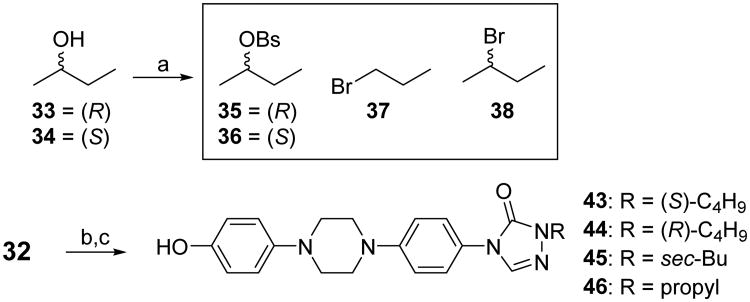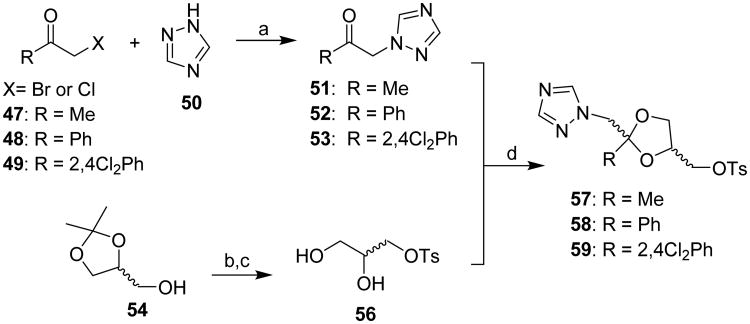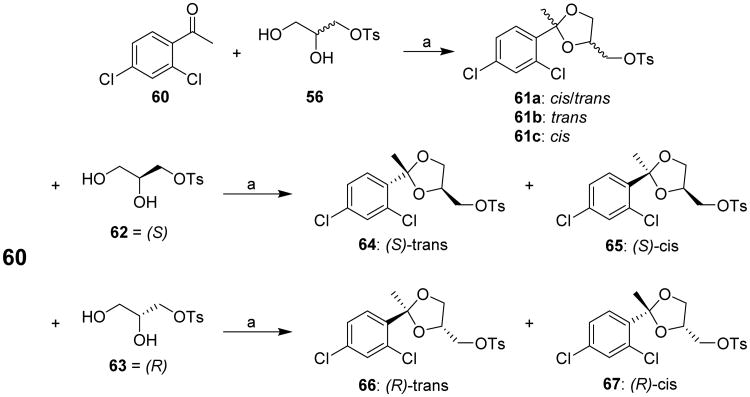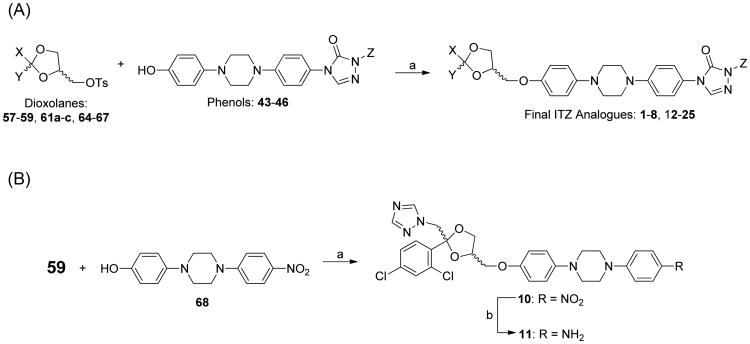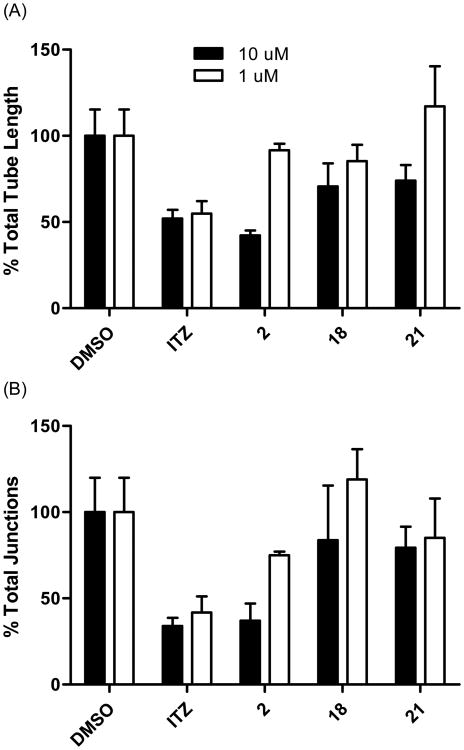Abstract
Itraconazole (ITZ) is an FDA-approved member of the triazole class of anti-fungal agents. Two recent drug repurposing screens identified ITZ as a promising anti-cancer chemotherapeutic that inhibits both angiogenesis and the hedgehog (Hh) signaling pathway. We have synthesized and evaluated first and second generation ITZ analogues for their anti-Hh and anti-angiogenic activities to more fully probe the structural requirements for these anti-cancer properties. Our overall results suggest that the triazole functionality is required for ITZ-mediated inhibition of angiogenesis, but that it is not essential for inhibition of Hh signaling. The synthesis and evaluation of stereochemically defined des-triazole ITZ analogues also provides key information as to the optimal configuration around the dioxolane ring of the ITZ scaffold. Finally, the results from our studies suggest that two distinct cellular mechanisms of action govern the anti-cancer properties of the ITZ scaffold.
Graphical abstract
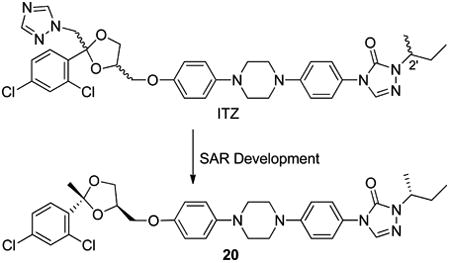
Introduction
Identifying novel biological activities of FDA-approved drugs has emerged as a viable strategy to expedite the drug discovery process. The pharmacokinetic and toxicological profiles of these compounds are well-understood and they are inherently “drug-like.” To this end, drug development researchers have made a concerted effort to incorporate small molecule libraries containing approved drugs in their high-throughput screens. Recently, two such screens designed to repurpose FDA-approved compounds as anti-cancer chemotherapeutics identified itraconazole (ITZ) as both an inhibitor of the hedgehog (Hh) signaling pathway (IC50 = 690 nM) and angiogenesis (IC50 = 160 nM).1-2 ITZ is a clinically efficacious member of the 1,2,4-triazole class of anti-fungal agents that exerts its antimycotic effects through potent inhibition of lanosterol 14α-demethylase (14LDM, also known as CYP51), a cytochrome P450 enzyme that catalyzes the oxidative conversion of lanosterol to ergosterol.3
The Hh pathway is a signaling cascade responsible for cell proliferation, differentiation, and tissue growth in embryogenesis.4-5 In healthy adults, the Hh pathway is considered less active and its primary role is maintaining stem cells in the skin and neural systems. Dysregulation of the Hh pathway, through a variety of different mechanisms, can lead to its constitutive activation, uncontrolled cellular proliferation, and tumor growth. Aberrant Hh pathway activation has been identified in a variety of cancers; however, the two most commonly identified as Hh-dependent are basal cell carcinoma (BCC) and medulloblastoma (MB).6-8 Because a significant portion of both BCCs (70%) and MBs (25%) rely on Hh signaling for tumorigenesis, it has drawn considerable interest for the development of targeted anti-cancer agents.9-10
The importance of angiogenesis in tumor formation, growth, and metastasis is well-documented and numerous small molecules and biologics that inhibit angiogenesis are clinically useful anti-cancer agents.11-13 These angiogenesis inhibitors are primarily utilized to indirectly arrest tumor growth by inhibiting the growth of blood vessels and depriving tumor cells of oxygen and nutrients. In certain cases, combination therapy including a traditional first-line chemotherapy and an anti-angiogenic agent has demonstrated improved efficacy when compared to the chemotherapy alone.14 In addition, while most chemotherapeutic agents are toxic and confer resistance, anti-angiogenic agents have only shown mild side effects and there are no reported incidents of resistance.15-16
Although ITZ is clinically efficacious, several of its overall features are not inherently “drug-like”. The molecular weight of ITZ (706 g/mol) is above the threshold typically targeted for small molecule therapeutics (500 g/mol). Multiple formulations of ITZ have been developed and evaluated to improve its oral bioavailability and overall pharmacokinetic profile.17-18 In addition, the triazole moiety of ITZ has the ability to coordinate with the heme of CYP450s; most notably, CYP3A4, and ITZ-mediated inhibition of CYP3A4 is responsible for multiple drug-drug interactions and adverse side effects.19 If ITZ is to be used as a chemotherapeutic, drug-drug interactions need to be minimized as cancer patients are often taking multiple medications to both treat the cancer and manage symptoms. Herein we report the synthesis and evaluation of an extensive series of itraconazole analogues designed to probe the scaffold for the identification of functionalities required for its anti-Hh and anti-angiogenic properties.
Results
Analogue Design
As noted above, the triazole moiety of ITZ is both required for its anti-fungal properties and responsible for its main detrimental side effect, inhibition of CYP3A4. The N4 of the ITZ triazole interacts with the heme group in CYP51 and CYP3A4 to prevent coordination of the molecular oxygen required to initiate oxidation.20-21 In addition to the triazole containing dioxolane region of the ITZ scaffold, ITZ contains a central phenyl-piperazine-phenyl linker region and a triazolone/side chain region (Chart 1). Within the context of its anti-fungal activity, the extended linker and triazolone/side chain regions are not essential for binding the active site of CYP51; however, they do interact with several amino acid residues in the substrate access channel.22 ITZ contains three chiral centers (2, 4, and 2′) and can potentially exist as a mixture of eight distinct stereoisomers; however, formation of the cis-configurations around the dioxolane ring predominates during its synthesis and pharmaceutical preparations of ITZ are typically administered as a 1:1:1:1 mixture of the cis diastereomers.23
Chart 1.
Structure and regions of itraconazole (ITZ).
To date, the only structural component of ITZ explored for Hh inhibition is the side chain region.24 These side chain derivatives, as well as a series of stereochemically defined ITZ analogues, have been explored for their anti-angiogenic properties;24-25 however, an in-depth exploration of the structural requirements of the ITZ scaffold for these anti-cancer properties has not been undertaken. We have prepared and evaluated a first generation series of ITZ analogues that systematically truncates the scaffold from both the left- and right-hand side to identify key structural features required for inhibition of both Hh signaling and angiogenesis (Table 1).
Table 1.
First generation series of ITZ analogues.

| |||
|---|---|---|---|
| Compound | R1 | R2 | R3 |
| 1, ITZ |
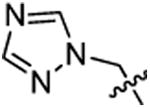
|

|

|
| 2 | -CH3 |

|

|
| 3 |
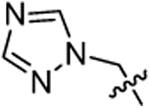
|
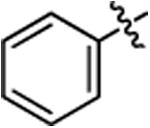
|

|
| 4 |
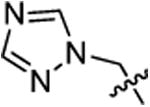
|
-CH3 |

|
| 5 | -CH3 | -CH3 |

|
| 6 |
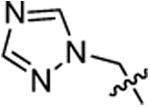
|

|

|
| 7 |
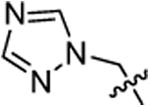
|

|

|
| 8 |
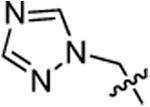
|

|

|
| 9 |
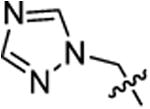
|

|
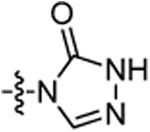
|
| 10 |
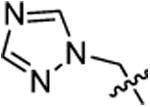
|

|
-NO2 |
| 11 |
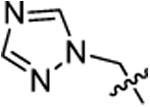
|

|
-NH2 |
Evaluation of this first generation series provided key structure-activity relationship (SAR) data that was subsequently utilized for the design of a second generation of stereochemically defined ITZ derivatives based on analogue 2 (Table 2). The second generation series was designed to determine whether a specific stereoisomer of key ITZ analogue 2 was responsible for its anti-Hh and/or anti-angiogenic properties.
Table 2.
Second generation, stereochemically defined analogues of 2.

| |||
|---|---|---|---|
| Compound | R1 | R2 | Final Stereochemistry |
| 12 |

|

|
Trans-2,4 |
| 13 |

|

|
Cis-2,4 |
| 14 |

|

|
Trans-2S,4S,2′S |
| 15 |

|

|
Cis-2R,4S,2′S |
| 16 |

|

|
Trans-2R,4R,2′S |
| 17 |

|

|
Cis-2S,4R,2′S |
| 18 |

|

|
Trans-2S,4S,2′R |
| 19 |

|

|
Cis-2R,4S,2′R |
| 20 |

|

|
Trans-2R,4R,2′R |
| 21 |

|

|
Cis-2S,4R,2′R |
| 22 |

|

|
Trans-2R,4R |
| 23 |

|

|
Cis-2S,4R |
| 24 |

|

|
Trans-2S,4S |
| 25 |

|

|
Cis-2R,4S |
Chemistry
Analogues 1-25 were synthesized following slightly modified literature procedures. All of these analogues contain the phenyl-piperazine-phenyl linker region of ITZ, which is initially constructed by a coupling step between commercially available N-(4-methoxyphenyl)-piperazine 26 and 1-chloro-4-nitrobenzene 27 to yield N-(4-hydroxylphenyl)-N′-(4-nitrophenyl)-piperazine 28 (Scheme 1). The nitro moiety in 28 is reduced to the aniline 29 in the presence of hydrazine monohydrate and 10% palladium on charcoal.25 The aniline undergoes a series of well-characterized transformations to ultimately provide the key triazolone intermediate 32. The methoxy substituent in starting material 26 serves as a protecting group throughout Scheme 1 and while other literature sources protect this phenol with a methoxymethyl (MOM) group, we found the synthetic scheme utilizing the MOM protection to be significantly less efficient in generating the corresponding key intermediate.24
Scheme 1.
Synthesis of linker region intermediate.a
aReagents and conditions: (a) K2CO3, reflux, 12 h, 82%; (b) Pd/C, NH2NH2•H2O (10 eq), reflux, 3.5 h, 71%; (c) Pyr (17 eq), ClCOOPh (1.1 eq), 3 h, 90%; (d) NH2NH2•H2O (5.5 eq), reflux, 3 h, quant; (e) formamidine acetate (4.5 eq), acetic acid, reflux, 3 h, 91%.
Triazolone 32 was alkylated with either commercially available alkyl bromides (37-38) or alkyl brosylates (35-36), which were prepared from the corresponding commercially available and stereochemically defined alcohols (33-34) (Scheme 2).25 The methoxy group in the linker/triazolone/side chain intermediates (39-42) was removed with 48% hydrobromic acid in toluene to afford the phenols 43-46 26 It is important to note that alkylation of the triazolone results in an inversion of stereochemistry for the defined side chains; for example, (R)-brosylate 35 generates (S)-intermediates 39 and 43.
Scheme 2.
Synthesis of linker/triazolone/side chain intermediates.a
aReagents and conditions: (a) Et3N, BsCl (1.3 eq), RT, 3 h; 30-50%; (b) Cs2CO3, brosyl/bromo alkyl chain, RT, 12 h, 45-88% (c) 48% HBr, toluene, reflux, 12 h, 55-80%.
The dioxolane regions were obtained via two different mechanisms due to their structural differences. Dioxolane regions that contained the triazole moiety could not be directly formed under standard ketalization procedures due to the basicity of the triazole functionality. For these intermediates, the triazole moiety (50) was added to various halogenated ketones (47-49) to form the triazole containing ketones (51-53). In parallel, tosylated glycerol 56 was formed through standard tosylation of the commercially available dioxolane 54 and subsequent acid-mediated hydrolysis (Scheme 3). Final dioxolane region intermediates containing the triazole moiety (57-59) were prepared through ketalization of 51-53 and 56 with triflic acid.
Scheme 3.
Synthesis of triazole-containing dioxolane region intermediates.a
aReagents and conditions: (a) NaHCO3, toluene, reflux, 3h, 25-65%; (b) Pyr, TsCl, 0°C- RT, 12 h, 71%; (c) MeOH, 0.5N HCl, reflux, 5 h, 89%; (d) Triflic acid (3-4 eq), toluene, RT, 60 h 10-70%.
The des-triazole dioxolane regions (61a-c and 64-67) were synthesized under standard ketalization reaction conditions utilizing a Dean-Stark apparatus (Scheme 4).27 Stereochemically defined tosylated glycerols 62 and 63 were prepared via the method described above for the racemic mixture and each of the protected glycerols was used to ketalize 2,4-dichloroacetophenone.25 For the stereochemically defined dioxolanes, the cis-isomer was predominantly formed (∼3:1 cis:trans) and the isomers were easily separable via column chromatography.
Scheme 4.
Synthesis of des-triazole dioxolane region intermediates.a
aReagents and conditions: (a) p-TsOH (cat.), toluene, reflux (Dean Stark), 48 h, 70-90%.
Tosylated dioxolane regions were coupled with the linker/triazolone/side chain region phenols in anhydrous dimethyl sulfoxide with cesium carbonate to yield the final analogues 1-8 and 12-25 (Scheme 5A). The truncated triazolone analogues (10-11) were synthesized in reverse order.25 The unprotected linker region 6824 was prepared in the same manner as 28 in Scheme 1 (Scheme 5B). This linker region intermediate was then coupled with the tosylated dioxolane region 59 under similar conditions described above to afford truncated analogue 10, which was reduced to the aniline with palladium on charcoal (10%) in the presence of hydrazine monohydrate to afford ITZ analogue 11.24 Overall purification methods varied for each ITZ analogue, particularly amongst the first generation series that contained the triazole moiety. Purification methods for all compounds are listed in the experimental or supplemental information.
Scheme 5.
Coupling reactions for final ITZ analogues.a
aReagents and conditions: (a) Cs2CO3 (10 eq), DMSO, 90°C, 12 h, 45-88%; (b) Pd/C, NH2NH2•H2O (10 eq), reflux, 3.5 h, 60-70%. The functional groups represented by X, Y, and Z above can be found in Schemes 2-4.
Biological Evaluation
The initial evaluation of first generation ITZ analogues (1-11) as Hh pathway inhibitors was performed by monitoring endogenous Gli1 mRNA levels in C3H10T1/2 cells, an Hh-dependent mouse embryonic fibroblast (MEF) at a single concentration (1 μM). In this well-studied model system for evaluating small molecule inhibition of Hh signaling, addition of an exogenous Hh agonist (recombinant Hh ligand or small molecule) results in a characteristic increase in Gli1 mRNA expression.28 Concomitant incubation with a pathway inhibitor reduces Gli1 expression. Analogues that reduced Gli1 mRNA levels below 20% in this assay were subsequently evaluated for their ability to reduce Gli1 mRNA expression levels in a concentration-dependent fashion in these cells and the Hh-dependent murine BCC cell line ASZ.30-31 In addition, several compounds were evaluated for their anti-proliferative effects in primary Hh-dependent medulloblastoma cells isolated from conditional patched knockout (Math1-Cre-ER;Ptcfl/fl, MERP) mice.32-34 Based on the primary nature of the MERP cells, only a small subset of 1st and 2nd generation ITZ analogues were chosen for evaluation in these cells. Finally, each of these analogues was evaluated for its ability to inhibit proliferation in human umbilical vein epithelial cells (HUVECs). In vivo angiogenesis is dependent on endothelial cell proliferation; therefore, the inhibition of HUVEC proliferation is commonly utilized as an early stage in vitro model of anti-angiogenic activity.24-25 In addition, the identification of ITZ as an anti-angiogenic compound was established via this assay.2 The results for these assays are given in Table 3.
Table 3.
In vitro activity of first generation ITZ analogues.
| Compound | % Gli expression (1μM)a | IC50 (μM)c | GI50 (μM)c | GI50 (μM)c | |
|---|---|---|---|---|---|
| C3H10T1/2a | ASZd | HUVEC | MERP MBd | ||
|
| |||||
| ITZ | --- | 0.074 ± 0.02 | 0.14 ± 0.02 | 0.40 ± 0.03 | 0.44 ± 0.08 |
| 1 | 1.7 ± 0.3b | 0.063 ± 0.003 | 0.17 ± 0.01 | 0.49 ± 0.09 | 0.6 ± 0.1 |
| 2 | 17.8 ± 0.5 | 0.14 ± 0.04 | 0.17 ± 0.04 | 23.8 ± 6.7 | ND |
| 3 | 13.1 ± 1.2 | 0.42 ± 0.2 | 0.45 ± 0.06 | 8.3 ± 0.7 | ND |
| 4 | 61.4 ± 3.5 | ND | ND | 18.4 ± 4.5 | ND |
| 5 | 71.4 ± 5.5 | ND | ND | >100 | ND |
| 6 | 6.9 ± 3.1 | 0.16 ± 0.04 | 0.14 ± 0.008 | 2.5 ± 0.3 | ND |
| 7 | 3.0 ± 0.9 | 0.14 ± 0.04 | 0.16 ± 0.07 | 1.7 ± 0.4 | ND |
| 8 | 58.5 ± 6.4 | ND | ND | 4.7 ± 0.3 | ND |
| 9 | 1.1 ± 0.2 | 0.043 ± 0.02 | 0.12 ± 0.03 | 5.8 ± 0.8 | ND |
| 10 | 1.5 ± 0.05 | 0.13 ± 0.03 | 0.09 ± 0.01 | 8.4 ± 0.7 | ND |
| 11 | 6.1 ± 1.6 | 0.16 ± 0.06 | 0.12 ± 0.05 | 42.7 ± 4.4 | 0.9 ± 0.7 |
| 45 | 45.7 ± 3.0 | ND | ND | >100 | ND |
All analogues evaluated following 24 hr incubation.
Values represent %Gli1 expression relative to recombinant Hh ligand control (set as 100%).
IC50 and GI50 values represent the Mean ± SEM of at least two separate experiments performed in triplicate.
All analogues evaluated following 48 hr incubation.
Evaluation of the first generation of ITZ analogues indicated several structural features that appear necessary for Hh pathway inhibition. While the absolute stereochemistry at the 2′-position of the sec-butyl side chain does not appear important, 6 and 7 are equipotent in the MEF and ASZ cell lines, removing the methyl moiety (8) significantly reduces the overall activity of the scaffold. Interestingly, removing the side chain (9) or the triazolone/side chain (10-11) did not affect the Hh inhibitory activity of the scaffold as each of these analogues also demonstrated potent inhibition of pathway signaling in each cell line with IC50 levels comparable to ITZ. In regards to modifications to the dioxolane region, removal of the chlorine atoms on the phenyl ring had minimal effects (3), while complete truncation of the phenyl ring (4) resulted in a significant loss of anti-Hh activity. Removal of the triazole moiety (2) had no effect on the ability of the scaffold to inhibit Hh signaling. Not surprisingly, removal of both the triazole and phenyl ring (5) or complete truncation to the phenol (45), significantly reduced Hh inhibitory activity. Our synthesized ITZ (1) demonstrated comparable activity to the ITZ purchased commercially in each of the cell lines evaluated. Finally, while each of the analogues evaluated was equipotent in its ability to down-regulate Gli1 mRNA expression in both the C3H10T1/2 and ASZ cells (Table 3), the ability of ITZ, 1, and 11 to inhibit the proliferation of Hh-dependent murine MB cells was slightly reduced.
In addition to exploring Hh pathway inhibition, this first generation of ITZ analogues was evaluated for their ability to inhibit VEGF-induced proliferation in HUVECs, an initial step towards determining their ability to inhibit angiogenesis. The ITZ synthesized in the lab (1) demonstrated anti-proliferative activity comparable to the commercially purchased ITZ (GI50 values = 0.49 and 0.40 μM, respectively). The remaining ITZ analogues were significantly less active than ITZ in this assay. Several analogues were moderately active (GI50 values, 1.7-8.4 μM), but none were comparable to ITZ. Finally, we compared ITZ and 2 for their ability to inhibit CYP3A4. Not surprisingly, removal of the triazole moiety completely abolished the ability of 2 to inhibit CYP3A4 (IC50 values = 50.4 nM and >10 μM, respectively, Supplementary Figure 1).
As noted above, the synthetic route primarily utilized to access ITZ results in a 1:1:1:1 ratio of four stereoisomers that share the cis configuration for the triazole and ether linker around the dioxolane ring. As a means to optimize our time and efforts related to the synthesis and evaluation of our first generation series of ITZ analogues, we did not fully characterize the ratio of stereoisomers present in each of the analogues. Instead they were evaluated as the stereoisomeric mixtures produced via the synthetic route(s) described. In order to more fully probe the absolute structural requirements of the scaffold for potent inhibition of Hh signaling and angiogenesis, we synthesized and evaluated a second generation series of stereochemically defined ITZ analogues based on the des-triazole ITZ analogue 2. It is important to note that the nomenclature of the stereochemistry regarding the dioxolane region differs between ITZ and des-triazole ITZ analogues. The triazole moiety receives priority within the fully intact ITZ dioxolane region; therefore, the cis-orientation is in reference to the triazole and ether linkage (Chart 2). By contrast, removal of the triazole shifts priority to the phenyl ring and a cis- des-triazole analogue has the opposite absolute configuration between the phenyl ring and ether linker as ITZ. In addition, coupling of the dioxolane region intermediates to the linker/side chain phenol results in the opposite nomenclature assignment for the final ITZ analogue, for example, final analogues that have the 4R stereochemistry were prepared from the (S) tosylate 62.
Chart 2.
Cis- and trans- nomenclature of dioxolane region: (A) representative cis-ITZ isomer, (B) cis- and (C) trans- des-triazole analogues.
Evaluation of our stereochemically defined analogues for their ability to inhibit Hh signaling in the C3H10T1/2 and ASZ cell lines provided both interesting and confounding results. Overall, the majority of the compounds evaluated (12-25, Table 4) were more active in the ASZ cells, with numerous analogues exhibiting 100- to 1000-fold improvement in activity in these cells when compared to the MEFs. Several analogues that were inactive in the C3H10T1/2 MEFs at concentrations up to 10 μM (15, 24-25) induced potent down-regulation of Gli1 (IC50 values = 0.55, 0.2, and 0.54 μM, respectively). In addition, several other compounds with modest inhibitory effects in the MEF cell line (13, 17, and 21) exhibited low nanomolar IC50 values in the ASZ cells.
Table 4.
In vitro activity of second generation ITZ analogues.
| Compound | IC50 (μM)a | GI50 (μM)a | GI50 (μM)a | |
|---|---|---|---|---|
| C3H10T1/2b | ASZc | HUVEC | MERPMBc | |
|
| ||||
| 12 | 0.091 ± 0.02 | 0.077 ± 0.01 | 3.32 ± 0.55 | 2.0 ± 1.3 |
| 13 | 0.85 ± 0.1 | 0.071 ± 0.02 | 3.69 ± 1.1 | 2.9 ± 1.9 |
| 14 | 1.1 ± 0.17 | 2.5 ± 0.7 | 7.7 ± 4.4 | ND |
| 15 | >10 | 0.55 ± 0.07 | 78.3 ± 17.3 | ND |
| 16 | 0.47 ± 0.001 | 0.38 ± 0.07 | 18.3 ± 11.8 | ND |
| 17 | 1.85 ± 0.09 | 0.15 ± 0.038 | 2.5 ± 0.7 | 0.39 ± 0.2 |
| 18 | 0.54 ± 0.24 | 0.13 ± 0.04 | 12.1 ± 4.7 | ND |
| 19 | 6.6 ± 0.3 | 2.8 ± 0.9 | 65.0 ± 11.5 | ND |
| 20 | 0.19 ± 0.04 | 0.022 ± 0.01 | 53.2 ± 25.2 | 0.6 ± 0.2 |
| 21 | 2.4 ± 0.6 | 0.024 ± 0.02 | 12.8 ± 2.9 | 1.0 ± 0.5 |
| 22 | 4.1 ± 1.5 | 1.3 ± 0.65 | 26.5 ± 3.5 | ND |
| 23 | >10 | 1.4 ± 0.5 | 49.9 ± 15.9 | ND |
| 24 | >10 | 0.2 ± 0.08 | 84.1 ± 33.5 | 22.4 ± 12 |
| 25 | >10 | 0.54 ± 0.06 | 24.9 ± 2.2 | ND |
| PSZ | 0.14 ± 0.02 | 0.54 ± 0.05 | 1.6 ± 0.02 | 1.5 ± 0.3 |
IC50 and GI50 values represent the Mean ± SEM of at least two separate experiments performed in triplicate.
All analogues evaluated following 24 hr incubation.
All analogues evaluated following 48 hr incubation.
Even with the conflicting results between cell lines, several interesting SAR developments with respect to optimal configuration were identified for our second generation ITZ analogues. First, these results reiterated that the orientation of the methyl moiety in the sec-butyl side chain is less important, as long as it is present (Table 4). Compounds that included a propyl moiety were significantly less active than analogues maintaining the same orientation around the dioxolane ring (i.e. 17 and 23; 18 and 24) and incorporating the sec-butyl moiety. ITZ analogues with the trans-orientation around the dioxolane generally demonstrated enhanced down-regulation of Gli1 mRNA expression in both cell lines when compared to the corresponding cis analogues. Finally, compounds containing the 4R configuration were generally more active than corresponding analogues with the 4S configuration and des-triazole analogues with the trans 2R,4R configuration (16, 20, and 22) demonstrated the most comparable activity between the two cell lines.
Based on the anti-Hh activity of the stereochemically defined compounds in the C3H10T1/2 and ASZ cells, we evaluated several of these ITZ analogues in the primary MB cell line. The specific analogues selected for the anti-proliferative studies were chosen either because they were potent in both cell lines (12 and 20) or because they were significantly less active in the MEFs (13, 17, 21, 24). Measuring the anti-proliferative effects of these analogues in the Hh-dependent primary cell culture would not only provide additional in vitro data for the most active trans analogues, but might also serve to clarify the discrepancies in anti-Hh activity between the two immortalized cell lines. Not surprisingly, the mixtures of trans- (12) and cis- (13) stereoisomers were less active than the single stereochemically defined analogues. The most active analogue in this assay was 17 (GI50 = 0.39 μM), which has the cis 2R,4R configuration around the dioxolane moiety. Finally, the reduced anti-proliferative activity demonstrated for analogue 24 further highlights the importance of the methyl group on the side chain for Hh inhibition. Based on the anti-proliferative results in the MB cells, we chose to evaluate ITZ and three analogues (17, 20, and 21) for their ability to down-regulate endogenous Gli1 mRNA expression in the MERP MB cell line. Along with ITZ, each of these compounds exhibited potent down-regulation of mRNA expression in this assay further demonstrating their ability to inhibit Hh signaling (Table 5). It is important to note that the anti-Hh activity of the ITZ analogues in the MERP MB cells more closely correlated with the data obtained in the ASZ cells, suggesting that the immortalized BCC cell line may be a more appropriate early stage in vitro cellular model of Hh signaling for evaluating analogues based on the ITZ scaffold.
Table 5.
Down-regulation of Gli1 mRNA in MERP MB cells.
All analogues evaluated following 48 hr incubation.
IC50 values represent the Mean ± SEM of two separate experiments.
Following the initial identification of ITZ as an Hh pathway inhibitor, several additional azole anti-fungals were evaluated for their anti-Hh properties.1 Interestingly, the closely related, stereochemically defined triazole anti-fungal posaconazole (PSZ, Chart 2) was not explored in these early studies. Based on our findings that ITZ analogue 20 was the most consistent in its ability to inhibit pathway activity across multiple Hh-dependent cell lines, we also evaluated PSZ, which shares the same orientation around its tetrahydrofuran (THF) ring, in each of these assays. PSZ demonstrated potent down-regulation of Gli1 expression in the MEF and ASZ cell lines; however, it was significantly less active in the MERP cells. Taken together, these data strongly suggesting that the dioxolane and hydrophobic side chain of ITZ are more active than the corresponding THF and hydroxylated side chains of PSZ.
The second generation of ITZ analogues was also evaluated in the HUVECs for their anti-angiogenic activity. In a fashion similar to our initial series, each analogue evaluated in this assay was significantly less active than the commercially purchased ITZ. Interestingly, the trans- (12) and cis- (13) dioxolane mixtures were both more potent than the complete mixture (2). Our results did not yield a clear SAR pattern that distinguished one stereo-defined dioxolane region to be more potent against HUVEC anti-proliferation. The stereoisomer that had the lowest IC50, 17, contains the (R)-cis-dioxolane region and the (S)-sec-butyl group (IC50 = 2.5 ± 0.7 μM). When only the stereochemistry of the sec-butyl moiety is inverted (21), activity is attenuated (IC50 = 12.8 ± 2.9 μM). Overall, the (S)-sec-butyl analogues have lower IC50 values than the corresponding (R)-sec-butyl analogues. The same trend held true for the (R)-trans-dioxolane analogues (16 and 20); this was the most potent orientation determined from the Hh pathway evaluation. These results differ from the Hh pathway inhibitory activity of the scaffold in that the stereochemistry of the side chain region did not play a significant role in achieving potent inhibition. Taken together, there is not one dioxolane region that can be readily determined as the most potent across the second generation of ITZ analogues for inhibiting proliferation of HUVEC cells.
Based on the lack of clear SAR in the HUVEC cells, we sought to further explore the anti-angiogenic properties of ITZ and our analogues by evaluating their ability to inhibit tube formation in HUVECs grown on Matrigel. Under normal conditions, HUVECs plated and grown on Matrigel migrate towards each other, align, and form tubes that resemble in vivo capillary beds. This assay is generally considered a more robust model of angiogenesis as it requires several aspects of proper vessel formation, including adhesion, migration, and tube formation.29 As tube formation assays are inherently lower-throughput, we chose to evaluate only a few select compounds, including, ITZ, 2, 18, 21, and the well-characterized angiogenesis inhibitor suramin (positive control). These analogues were chosen for evaluation based on both their activity in the anti-proliferation assays and their overall structure in an attempt to provide the most relevant preliminary information with respect to the ability of this scaffold to inhibit angiogenesis.
Inhibition of tube formation (as measured by overall tube length and total tube junctions) by ITZ and 2 were comparable to that of the positive control suramin at 10 μM; however, neither of the stereochemically defined analogues (18 and 21) were active at this concentration (Figures 1 and 2). ITZ also demonstrated significant inhibition of tube formation at 1 μM. A decrease in activity was observed at 1 μM for analogue 2, highlighting the importance of the triazole moiety for optimal anti-angiogenic activity of the scaffold. Interestingly, there was minimal correlation between the ability of a compound to inhibit anti-proliferation and tube formation in the HUVEC cells. ITZ was most active in both assay systems; however, analogues 18 and 21 were two-fold more active in the anti-proliferation assay than 2, yet they were essentially inactive in the tube formation assay. Taken together, these data suggest that the triazole of ITZ is important for the anti-angiogenic activity of the scaffold and further SAR with respect to this region and its anti-cancer properties is warranted.
Figure 1.
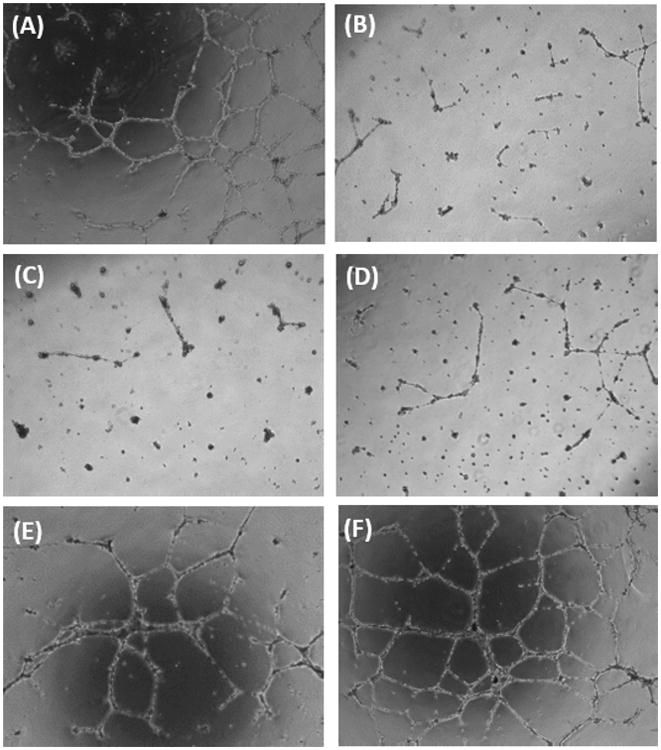
Tube formation assays for ITZ and its analogues. (A) DMSO, (B) Suramin, (C) ITZ, (D) 2, (E) 18, (F) 21. All compounds were evaluated at 10 μM and each image is a representative visual field from a single assay. Each assay was repeated at least three distinct times.
Figure 2.
Comparison of total tube length (A) and total tube junctions (B) for ITZ, 2, 18, and 21. DMSO (negative control) was set as 100% tube formation for analysis purposes. Suramin (10 μM) was used as the positive control for each experiment and its ability to inhibit tube length (51.9 ± 7.8%) and tube junctions (57.6 ± 6.1%) was consistent. Data represent the Ave ± SEM of at least 3 separate experiments in which ≥ 5 fields of vision were quantified using ImageJ software.
Discussion and Conclusions
The identification of two distinct anti-cancer activities for the FDA approved drug ITZ prompted our exploration of the structural characteristics of this scaffold that govern these activities. Based on previously published SAR for the side chain region of the ITZ scaffold,24 it was not surprising that our preliminary data suggests no correlation between the anti-Hh and anti-angiogenic activity of these scaffolds. Significant modifications to multiple regions of the scaffold resulted in compounds that retained the ability to inhibit Hh signaling in Hh-dependent MEFs, murine BCC cells, and murine MB cells. By contrast, every analogue evaluated was significantly less active than ITZ in the anti-angiogenic assays performed in HUVECs. Preliminary data provides strong evidence that ITZ inhibits the Hh pathway through Smoothened (Smo), a key regulator of this signaling cascade. As neither Smo nor Hh signaling are known to play a role in angiogenesis, it is reasonable to hypothesize that the anti-angiogenic properties of ITZ are mediated through a distinct, as yet unidentified, cellular target not associated with this developmental pathway; however, further studies are needed to definitively characterize Smo/ITZ binding interactions and identify the cellular protein(s) responsible for its ability to inhibit cellular angiogenesis.
A key goal for our initial ITZ analogue series was to determine whether the triazole moiety was essential for the anti-cancer properties of the scaffold. Removal of the triazole from the dioxolane region (2) had no effect on the ability to inhibit Hh signaling in either cell line; however, it did significantly affect the anti-angiogenic properties of the scaffold. This also provides further evidence that the anti-cancer activities of ITZ are mediated through distinct cellular mechanisms and highlights the importance of the triazole for the ability of ITZ to inhibit angiogenesis. Not surprisingly, removal of the triazole completely abolished inhibition of CYP3A4, the main detrimental side effect of ITZ, providing an improved lead scaffold for further development as an inhibitor of Hh signaling.
After establishing that the triazole functionality is not required for Hh inhibition, we prepared and evaluated two additional series of analogues to (1) determine whether truncation at other locations affected the anti-Hh properties of the scaffold and (2) identify the optimal stereochemical orientation of our new lead 2. The truncated analogues were not only designed to identify the pharmacophore for ITZ inhibition of Hh signaling, but also to reduce the overall size of ITZ (molecular weight = 705.6 g/mol) to improve both its drug-like properties and the overall synthetic efficiency of preparing these compounds. Overall, the dioxolane region was not amenable to further truncation; however, removing the triazolone/side chain region did not affect the ability of the scaffold to inhibit Hh signaling in any of the Hh-dependent cell lines (analogue 11). For the stereochemically defined analogues of 2, the trans orientation was preferred for the dioxolane region and more specifically the trans 2R,4R analogues were consistently more active than other analogues with their respective side chain orientation in the immortalized cell lines. In the primary murine MB cells, a cis analogue (17) with the 4R orientation also demonstrated potent anti-proliferative effects, suggesting that the (R)-configuration at the 4-position of the dioxolane ring might be more important for Hh inhibition than the overall cis- or trans- orientation. This is further highlighted by the significant reduction in anti-proliferative activity for analogue 24 (trans-2S,4S).
While the active first generation ITZ analogues demonstrated comparable Hh inhibition in both the C3H10T1/2 and ASZ cell lines, the second generation, stereochemically defined analogues were generally more active in the ASZs. Several possibilities exist to explain the differential activity identified for the second generation analogues. First, it is possible that decreased permeability for the stereochemically defined compounds in the C3H10T1/2 cells prevents their intracellular accumulation at concentrations required for potent activity. Second, the cellular target that mediates the anti-Hh activity of the ITZ scaffold (presumably Smo) may be more responsive to the stereochemically defined analogues in the ASZ cells. In addition, Hh signaling in the C3H10T1/2 cells must be activated through the addition of an exogenous agonist (for these assays, recombinant sonic Hh ligand), while Hh signaling and Gli1 overexpression are constitutively active in the ASZ cells due to a heterozygous mutation in the PTCH1 allele.30-31 Up-regulation of pathway signaling with the Hh ligand in the MEFs may result in a level of Gli1 overexpression that cannot be fully overcome by the ITZ analogue(s). Finally, complete inhibition of Hh signaling for the ITZ scaffold may rely on the presence of multiple stereoisomers to fully inhibit its target, which could explain why the isomeric mixtures in the first generation demonstrated comparable activity across both cell lines. These discrepancies are currently being addressed in ongoing studies to more fully understand the mechanisms that govern ITZ-mediated inhibition of both cell lines.
A consideration for the further development of these and other ITZ analogues as potential Smo antagonists is that multiple forms of mutant Smo have been identified in both BCC and MB patients receiving a small molecule Smo antagonists.36-40 These mutations in Smo oftentimes render patients insensitive to further treatment with the Smo antagonists that have been approved by the FDA. A key rationale for developing ITZ analogues as Hh pathway inhibitors is that ITZ has previously demonstrated the ability to inhibit several resistant forms of Smo in vitro and in vivo;1,41 however, any further development of these analogues as Hh inhibitors must demonstrate that they also prevent pathway signaling in the presence of mutant Smo. Attempts to circumvent mutant Smo by Developing small molecule Hh pathway inhibitors that function downstream of Smo at the level of the Gli transcription factors has emerged as a potential strategy to circumvent mutant Smo; however, all of the Gli inhibitors reported to date demonstrate only modest inhibition of Hh signaling, suggesting more studies are necessary to determine whether directly targeting Gli(s) is a valid therapeutic strategy.42
In conclusion, we have synthesized and evaluated two series of ITZ analogues for their ability to inhibit both Hh signaling and angiogenesis. These studies have provided preliminary insight into the structural features required for potent inhibition of both of these cancer related pathways. Ongoing studies for the ITZ scaffold include further SAR exploration of the side chain and dioxolane region as well as studies designed to more fully understand the discrepancies in Hh inhibition demonstrated across the different Hh-dependent cell lines.
Experimental Section
Chemical Synthesis
General Information
Starting materials were purchased from Sigma-Aldrich or Fisher Scientific. ACS grade methanol, ethyl acetate, toluene, anhydrous DMF, NMP, and DMSO were purchased from Fisher Scientific or Sigma-Aldrich. ITZ analogue 9 was purchased from Toronto Research Chemicals. All reactions were run under an argon atmosphere. NMR data was collected on a Bruker AVANCE 500 MHz spectrometer and analysis performed using MestReNova. HRMS data was analyzed at the Mass Spectrometry Facility at the University of Connecticut by Dr. You-Jun Fu. FT-IR analysis was performed on a Bruker Alpha Platinum ATR instrument using OPUS software (v 7.2). The preparation of previously characterized ITZ intermediates followed known procedures with minor modifications.24-26,32 X-ray crystals were prepared using vapor diffusion techniques (pentanes:chloroform) and analysis performed by Dr. Victor Day at the Small-Molecule X-ray Crystallography Lab at the University of Kansas on a Bruker MicroStar microfocus Cu rotating anode generator with two CCD detectors or a Bruker Apex II CCD detector equipped with Helios multilayer optics instruments. Mercury (v3.0) software was used to visualize X-ray structural analysis. All ITZ analogues evaluated in the biological assays (1-25) were greater than 95% pure based on the HPLC methods described below.
Purity Analysis of Final Analogues
It is important to note that final ITZ analogues 1-11 were synthesized and evaluated as stereoisomeric mixtures. For this initial series, we did not separate individual stereoisomers nor did we determine the ratios of cis:trans dioxolanes produced in the ketalization reaction. These mixtures are reflected in the 1H and 13C NMR characterization data described below and the spectra provided in the supplementary information. Purity analysis for all final analogues was determined via one of the methods described below.
Method A
ITZ analogues were dissolved in HPLC grade MeCN and injected (20 μl of a 1 mM soln) into an Agilent Manual FL-Injection Valve (600 bar) on an Agilent 1100/1200 Series HPLC equipped with an Agilent Eclipse Plus C18 (4.6 × 100 mm) column and Agilent 1100 Series Photodiode Array Detector. The mobile phase consisted of 60% MeCN:40% H2O for analogues containing the triazole moiety and 70% MeCN:30% H2O for des-triazole analogues. All analogues were run at a flow rate of 1.0 mL/min for 20 mins and purity was assessed at 254 nm.
Method B
ITZ analogues were dissolved in HPLC grade MeCN and injected (20 μl of a 1 mM soln) into an Agilent HPLC system coupled to an Agilent ESI single quadrupole mass spectrometer equipped with a Kinetix C18 (150 × 4.6 mm) column and an Agilent G1315 diode array detector. The mobile phase consisted of 70% MeCN:30% H2O. All analogues were run at a flow rate of 0.7 mL/min for 30 mins and purity was assessed at 254 nm.
Previously Characterized ITZ Intermediates
Common ITZ linker region (28-32 and 68), dioxolane region (53-56, 59, 62-63), side chain (35-36), and coupled intermediates were prepared primarily as described previously for the ITZ scaffold with the minor modifications described in the supplementary info.24-26,35 Procedures and characterization for newly reported key intermediates and all final analogues is provided below.
First Generation ITZ Intermediates and Final Analogues (1-11)
1-(1H-1,2,4-triazol-1-yl)propan-2-one (51)
A solution of chloroacetone (47) (1.72 mL, 21.6 mmol), 1H-1,2,4-triazole (50) (2.98 g, 43.2 mmol), NaHCO3 (2.89 g, 34.5 mmol), and toluene (100 mL) were heated to reflux (110-120°C) for 3 h. The reaction vessel was cooled to -20°C for 12 h. The resulting precipitate was filtered, dissolved in H2O, and extracted with EtOAc (50 mL × 3). The organic layer was collected, washed with saturated sodium chloride (100 mL), and dried (Na2SO4). The solvent was evaporated and the crude product was purified via column chromatography (SiO2, 0 - 3% MeOH in DCM) resulting in a yellow oil (600 mg, 22.2%). 1H NMR (500 MHz, CDCl3) δ 8.01 (s, 1H), 7.76 (s, 1H), 4.90 (s, 2H), 2.00 (s, 3H). 13C NMR (126 MHz, CDCl3) δ 199.58, 151.41, 144.15, 57.52, 26.63. DART-HRMS: m/z calcd. for C5H7N3O [MH]+, 126.0667; Found: 126.0691. IR (solid) vmax: 3122, 2935, 2241, 1728, 1507, 1352, 1273, 1137, 1115, 727, 677, 646.
1-phenyl-2-(1H-1,2,4-triazol-1-yl)ethanone (52)
A solution of 2-bromoacetophenone (48) (2.0 g, 10.0 mmol), 1H-1,2,4-triazole (50) (1.4 g, 20.1 mmol), NaHCO3 (1.3 g, 16.1 mmol), and toluene (100 mL) were heated to reflux (110-120°C) for 3 h. The reaction vessel was cooled to -20°C for 12 h. The resulting precipitate was filtered, dissolved in H2O, and extracted with EtOAc (3 × 50 mL). The organic layer was collected, washed with saturated sodium chloride, and dried over sodium sulfate. The solvent was evaporated and the crude product was purified via column chromatography (SiO2, 0 - 3% MeOH in DCM) resulting in a yellow solid (1.2 g, 64.1%). 1H NMR (500 MHz, CDCl3) δ 8.28 (s, 1H), 8.04 (s, 3H), 7.70 (s, 1H), 7.57 (s, 2H), 5.71 (s, 2H). 13C NMR (126 MHz, CDCl3) δ 190.84, 152.02, 145.07, 134.69, 129.30, 128.25, 55.19. DART-HRMS: m/z calcd. for C10H9N3O [MH]+, 188.0824; Found: 188.0822. IR (solid) vmax: 3113, 3062, 2992, 2953, 1697, 1596, 1504, 1450, 1345, 1225, 1207, 1135, 1021, 888, 752, 687, 675, 656, 634.
(2-((1H-1, 2,4-triazol-1-yl) methyl)-2-methyl-1, 3-dioxolan-4-yl) methyl 4-methylbenzenesulfonate (57)
Ketone 51 (1.4 g, 11.9 mmol) and 56 (2.8 g, 11.5 mmol) were added to a dry round bottom flask. Anhydrous toluene (10 mL) was added and the mixture was cooled to 0° C at which time TfOH (4.0 mL, 45.9 mmol) was added dropwise with a glass syringe. The solution was stirred at RT for 60 h. The mixture was diluted with 50 mL of EtOAc and slowly added to a solution of K2CO3 (5 g) in water (40 mL). The aqueous layer was washed with EtOAc (3 × 50 mL) and the organic layers were combined, dried (Na2SO4), filtered, and concentrated. The crude product was purified via column chromatography (SiO2, 0 – 10% MeOH in DCM) (200 mg, <10%). 1H NMR (500 MHz, CDCl3) δ 8.10 (d, J = 8.3 Hz, 1H), 7.86 (s, 1H), 7.81 – 7.75 (m, 2H), 7.37 (m, 2H), 4.39 – 4.24 (m, 3H), 4.06 (m, 1H), 4.03 – 3.92 (m, 1H), 3.86 (m, 1H), 3.83 – 3.74 (m, 1H), 3.69 (m, 1H), 3.53 (m, 1H), 2.46 (d, J = 5.7 Hz, 3H), 1.32 (d, J = 5.9 Hz, 3H). 13C NMR (126 MHz, CDCL3) δ 152.04, 151.89, 145.75, 144.96, 132.89, 130.45, 130.39, 128.40, 74.56, 74.07, 68.83, 68.68, 67.17, 67.03, 55.93, 55.88, 23.77, 22.66, 22.09. DART-HRMS: m/z calcd. for C15H19N3O5S [MH]+, 354.1124; Found: 354.1124. IR (solid) vmax: 3007, 2989, 2916, 2894, 1594, 1557, 1359, 1172, 1093, 1035, 961, 873, 724, 662, 563.
(2-((1H-1,2,4-triazol-1-yl)methyl)-2-phenyl-1,3-dioxolan-4-yl)methyl 4-methylbenzenesulfonate (58)
Crude dioxolane 58 was prepared through a procedure analogous to that described above for 57. Following extraction with EtOAc, the combined organic layers were dried (Na2SO4), filtered, and concentrated to ∼70 mL EtOAc. A solution of TsOH monohydrate (2.0 g) in EtOAc (13 mL) was slowly added at RT. The product precipitated as a salt and was filtered (3.9 g). The salt was dissolved in aqueous saturated K2CO3 (100 mL) and washed with DCM (3 × 100 mL). The organic layers were combined, dried (Na2SO4) and used without further purification (62%). 1H NMR (500 MHz, CDCl3) δ 8.02 (s, 1H), 7.77 – 7.70 (m, 3H), 7.40 – 7.27 (m, 8H), 4.42 (d, J = 1.4 Hz, 2H), 4.22 – 4.13 (m, 1H), 3.75 (m, 2H), 3.61 (m, 1H), 3.47 (m, 1H), 2.42 (s, 3H). 13C NMR (126 MHz, CDCl3) δ 151.12, 145.23, 138.05, 132.33, 129.98, 129.27, 128.62, 127.94, 125.64, 108.44, 73.42, 68.52, 66.55, 55.71, 21.65. DART-HRMS: m/z calcd. for C20H21N3O5S [MH]+, 416.1280; Found: 416.1263. IR (solid) vmax: 3311, 3111, 2992, 2953, 2893, 1596, 1509, 1448, 1349, 1336, 1232, 1172, 1043, 968, 811, 736, 699, 611, 551.
(2-(2,4-dichlorophenyl)-2-methyl-1,3-dioxolan-4-yl)methyl 4-methylbenzenesulfonate (61a)
To a solution of 2′,4′-dichloroacetophenone (60) (20 g, 0.1 mol) in toluene (80 mL) was added glycerol (11 g, 0.12 mol) followed by a catalytic amount of p-toluenesulfonic acid monohydrate (475 mg, 2.5 mmol). A Dean-Stark trap (10 mL trap filled with 8 mL toluene) and condenser were fitted atop the reaction flask. The solution was refluxed for 48 h. Upon cooling, the mixture was diluted with EtOAc and washed sequentially with saturated sodium bicarbonate (3 × 100 mL), water (2 × 100 mL), and saturated sodium chloride (100 mL). The organic layer was dried (MgSO4), filtered, concentrated, and purified by column chromatography (SiO2, 3:1 Hex: EtOAc) to yield 61a as a clear oil in excellent yield (88%). 1H NMR (500 MHz, CDCl3) δ 7.78 (d, J = 8.2 Hz, 1H), 7.47 (m, 1H), 7.36 – 7.31 (m, 2H), 7.31 – 7.27 (m, 1H), 7.18 – 7.14 (m, 1H), 4.16 (m, 1H), 4.10 – 4.00 (m, 2H), 3.89 – 3.77 (m, 1H), 3.68 (m, 1H), 2.43 (s, 1H), 2.42 (s, 2H), 1.66 (d, J = 1.0 Hz, 3H). 13C NMR (126 MHz, CDCl3) δ 144.98, 13 7.50, 134.44, 132.50, 130.95, 130.69, 129.80, 129.74, 128.58, 128.11, 127.81, 127.71, 126.64, 126.56, 109.26, 109.23, 73.62, 72.69, 69.32, 68.53, 66.32, 65.98, 25.46, 25.38, 21.48. DART-HRMS: m/z calcd. for C18H18Cl2O5S [MH]+, 417.0330; Found: 417.0306. IR (solid) vmax: 2988, 2941, 2889, 1586, 1556, 1464, 1364, 1188, 1174, 1095, 1035, 979, 809, 662, 552.
4-(4-(4-(4-((2-((1H-1,2,4-triazol-1-yl)methyl)-2-(2,4-dichlorophenyl)-1,3-dioxolan-4-yl)methoxy)phenyl)piperazin-1-yl)phenyl)-2-(sec-butyl)-2,4-dihydro-3H-1,2,4-triazol-3-one (1)
To a solution of 45 (50 mg, 0.127 mol) in DMSO (2 mL) was added dioxolane tosylate 59 (67 mg, 0.139 mmol) followed by Cs2CO3 (0.41 mg, 1.27 mmol). The mixture was warmed to 80 °C and stirred for 16 h. The mixture was cooled to RT and water was added slowly (6 mL) with vigorous stirring to form a precipitate. The precipitate was filtered, washed with water, and determined to be the product with only DMOS as an impurity. The precipitate was dissolve in EtOAc (60 mL) and washed with water (50 mL). The aqueous layer was washed with EtOAc (1 × 50 mL) and the combined organic layers were dried (Na2SO4), filtered, and concentrated. The crude residue was purified by column chromatography (SiO2, 0-80% acetone in hexanes) and sonicated in pentanes to produce 1 as a white solid (62 mg, 69%). 1H NMR (500 MHz, CDCl3) δ 8.20 (d, J = 8.2 Hz, 1H), 7.91 (d, J = 10.6 Hz, 1H), 7.64 – 7.55 (m, 2H), 7.50 – 7.39 (m, 3H), 7.06 – 6.99 (m, 2H), 6.94 (d, J = 9.1 Hz, 1H), 6.88 (d, J = 8.9 Hz, 1H), 6.84 – 6.77 (m, 1H), 6.69 – 6.61(m, 1H), 4.88 – 4.70 (m, 2H), 4.40 – 4.19 (m, 2H), 3.96 – 3.87 (m, 1H), 3.85 – 3.76 (m, 2H), 3.54 – 3.44 (m, 1H), 3.36 (m, 4H), 3.23 (m, 4H), 1.87 (m, 1H), 1.72 (m, 1H), 1.39 (dd, J = 6.7, 1.4 Hz,3H), 0.91 (m, 3H). 13C NMR (126 MHz, CDCl3) δ 152.52, 152.43, 151.94, 151.49, 151.31, 150.45,145.94, 145.89, 144.81, 144.60, 135.98, 135.70, 134.97, 133.97, 133.81, 133.04, 132.89, 131.35,131.06, 129.52, 129.42, 127.15, 126.98, 125.87, 123.46, 118.37, 118.27, 116.58, 115.19, 115.08,74.62, 67.57, 67.37, 54.30, 53.53, 52.58, 50.49, 49.15, 28.35, 19.17, 10.70. DART-HRMS: m/zcalcd. for C35H38Cl2N8O4 [MH]+, 705.2471; Found: 705.2474. IR (solid) vmax: 3125, 2966, 2832, 1698, 1585, 1551, 1510, 1450, 1379, 1228, 1184, 1139, 1042, 976, 944, 824, 736. Purity: 98.0% (Method A).
1-(sec-butyl)-4-(4-(4-(4-((2-(2,4-dichlorophenyl)-2-methyl-1,3-dioxolan-4-yl)methoxy)phenyl)piperazin-1-yl)phenyl)-1H-1,2,4-triazol-5(4H)-one (2)
To a solution of 45 (64 mg, 0.163 mmol) in DMSO (10 mL) was added sodium hydride (1.14 mmol). The mixture was warmed to 50° C and stirred for 2 h. To this solution was added 61a (62 mg, 0.148 mmol in DMSO, 5 mL). The solution was warmed to 90° C and stirred for 12 h. The mixture was cooled to RT and H2O (30 mL) was added slowly with vigorous stirring. The mixture was washed with EtOAc (3 × 100 mL), and the organic layers were combined, dried (Na2SO4), filtered, and concentrated. The crude residue was purified by column chromatography (SiO2, 0-5% MeOH in DCM) to afford 2 as a reddish-brown solid in modest yield (34%). A portion of 2 was dissolved in chloroform and slow evaporation provided off-white crystals that were utilized for the biological assays. 1H NMR (500 MHz, CDCl3) δ 7.66 – 7.59 (m, 2H), 7.46 – 7.36 (m, 3H), 7.21 (m, 1H), 7.06 – 7.00 (m, 2H), 7.01 – 6.71 (m, 4H), 4.37 – 4.25 (m, 2H), 4.12 (m, 1H), 4.01 (m, 1H), 3.96 (m, 1H), 3.79 (m, 1H), 3.36 (d, J = 6.2 Hz, 4H), 3.31 – 3.17 (m, 4H), 1.89 – 1.82 (m, 1H), 1.82 (s, 3H), 1.78 (s, 1H), 1.72 (m, 1H), 1.39 (d, J = 6.7 Hz, 3H), 0.90 (t, J = 7.4 Hz, 3H). 13C NMR (126 MHz, CDCl3) δ 152.0, 150.5, 138.1, 134.5, 133.8, 132.8, 131.1, 128.8, 128.5, 126.7, 126.6, 125.9, 123.5, 118.4, 116.6, 115.5, 109.0, 73.9, 69.2, 66.9, 52.7, 50.6, 49.2, 28.4, 25.8, 25.7, 19.2, 10.7. DART-HRMS: m/z calcd. for C33H38Cl2N5O4 [MH]+, 638.2301; Found: 638.2298. IR (solid) vmax 2960, 2922, 2874, 2850, 1696, 1552, 1509, 1462, 1449, 1376, 1226, 1192, 1149, 1076, 1034, 870, 734. Purity: 98.0% (Method A).
4-(4-(4-(4-((2-((1H-1,2,4-triazol-1-yl)methyl)-2-phenyl-1,3-dioxolan-4-yl)methoxy)phenyl)piperazin-1-yl)phenyl)-1-(sec-butyl)-1H-1,2,4-triazol-5(4H)-one (3)
ITZ analogue 3 was prepared using the general method described above for analogue 1 utilizing the requisite linker/side chain and dioxolane intermediates (23 mg, 47%). 1H NMR (500 MHz, CDCl3) δ 8.20 (s, 1H), 7.91 (s, 1H), 7.61 (s, 1H), 7.57 – 7.51 (m, 2H), 7.46 – 7.34 (m, 5H), 7.06 – 7.00 (m, 2H), 6.96 – 6.90 (m, 2H), 6.82 – 6.76 (m, 2H), 4.54 (d, J = 1.6 Hz, 2H), 4.39 – 4.25 (m, 2H), 3.90 (dd, J = 8.4, 6.7 Hz, 1H), 3.77 (m, 2H), 3.44 (m, 1H), 3.39 – 3.33 (m, 4H), 3.26 – 3.16 (m, 4H), 1.93 – 1.80 (m, 1H), 1.78 – 1.65 (m, 1H), 1.39 (d, J = 6.8 Hz, 3H), 0.90 (t, J = 7.4 Hz, 3H). 13C NMR (126 MHz, CDCl3) δ 152.45, 151.61, 145.20, 139.21, 134.33, 129.63, 129.08, 126.23, 123.97, 118.89, 117.09, 115.69, 74.96, 68.39, 67.73, 56.33, 53.09, 51.03, 49.65, 28.86, 19.67, 11.21.DART-HRMS: m/z calcd. for C35H40N8O4 [MH]+, 637.3251; Found: 637.3271. IR (solid) vmax 3122, 3058, 2961, 2825, 1693, 1602, 1551, 1508, 1448, 1388, 1327, 1296, 1226, 1180, 1135, 1939, 944, 823, 736, 701, 676. Purity: 97.1% (Method A).
4-(4-(4-(4-((2-((1H-1,2,4-triazol-1-yl)methyl)-2-methyl-1,3-dioxolan-4-yl)methoxy)phenyl)piperazin-1-yl)phenyl)-2-(sec-butyl)-2,4-dihydro-3H-1,2,4-triazol-3-one (4)
ITZ analogue 4 was prepared using the general method described above for analogue 1 utilizing the requisite linker/side chain and dioxolane intermediates. (45%) 1H NMR (500 MHz, CDCl3) δ 8.30 – 8.10 (m, 1H), 7.94 (s, 1H), 7.62 (s, 1H), 7.43 (d, J = 8.5 Hz, 2H), 7.03 (d, J = 8.9 Hz, 2H), 6.97 – 6.87 (m, 2H), 6.84 (t, J = 9.9 Hz, 2H), 4.49 (t, J = 5.8 Hz, 1H), 4.39 (s, 1H), 4.36 – 4.24 (m, 2H), 4.15 (m, 1H), 4.03 – 3.84 (m, 1H), 3.79 (m, 1H), 3.69 – 3.59 (m, 1H), 3.42 – 3.33 (m, 4H), 3.24 (t, J = 5.0 Hz, 4H), 1.92 – 1.81 (m, 1H), 1.72 (m, 1H), 1.44 (s, 1H), 1.43 – 1.36 (m, 5H), 0.90 (t, J = 7.4 Hz, 3H).13C NMR (126 MHz, CDCl3) δ 152.7, 152.0, 151.4, 150.5, 145.9, 144.6, 133.9, 125.9, 123.5, 118.5, 118.4, 116.6, 115.3, 115.2, 108.0, 75.4, 74.8, 68.5, 67.7, 67.5, 67.1, 55.7, 55.6, 52.6, 50.6, 49.2, 28.4, 23.5, 22.5, 19.2, 10.7. IR (solid) vmax 3121, 3053, 2930, 2850, 2809, 1702, 1683, 1548, 1510, 1471, 1452, 1336, 1251, 1134, 1106, 1068, 1050, 940, 883, 735. DART-HRMS: m/z calcd. for C30H39N8O4 [MH]+, 575.3094; Found: 575.3090. IR (solid) vmax: 2967, 2934, 2878, 2837, 1701, 1554, 1510, 1450, 1382, 1225, 1181, 1136, 1042, 1017, 942, 826, 784. Purity: 95.1% (Method A).
1-(sec-butyl)-4-(4-(4-(4-((2,2-dimethyl-1,3-dioxolan-4-yl)methoxy)phenyl)piperazin-1-yl)phenyl)-1 H-1,2,4-triazol-5(4H)-one (5)
ITZ analogue 5 was prepared using the general method described above for analogue 2 utilizing the requisite linker/side chain and dioxolane intermediates. The crude residue was purified via column chromatography (SiO2, 0-5% MeOH in DCM) to afford 5 in modest yield (14 mg, 21%) 1H NMR (500 MHz, CDCl3) δ 7.61 (d, J = 7.2 Hz, 1H), 7.43 (d, J = 8.4 Hz, 2H), 7.03 (d, J = 8.5 Hz, 2H), 6.94 (s, 1H), 6.89 (d, J = 8.4 Hz, 2H), 4.46 (m, 1H), 4.29 (m, 1H), 4.16 (t, J = 7.4 Hz, 1H), 4.04 (m, 1H), 3.90 (m, 2H), 3.37 (s, 2H), 3.24 (s, 2H), 1.86 (m, 1H), 1.71 (m, 1H), 1.46 (s, 3H), 1.39 (d, J = 7.8 Hz, 6H), 0.91 (t, J = 7.4 Hz, 3H). 13C NMR (126 MHz, CDCl3) δ 152.44, 134.28, 124.08, 123.96, 118.93, 117.14, 115.81, 110.13, 74.49, 69.77, 67.32, 53.11, 51.11, 49.62, 33.08, 28.86, 27.22, 25.79, 19.66, 11.20. DART-HRMS: m/z calcd. for C28H37N5O4 [MH]+, 508.2924; Found: 508.2909. IR (solid) vmax: 3126, 3060, 2967, 2926, 2878, 2828, 2212, 1681, 1584, 1556, 1510, 1452, 1380, 1226, 1149, 1037, 941, 819, 736. Purity: 97.5% (Method B).
4-(4-(4-(4-((2-((1H-1,2,4-triazol-1-yl)methyl)-2-(2,4-dichlorophenyl)-1,3-dioxolan-4-yl)methoxy)phenyl)piperazin-1-yl)phenyl)-2-((S)-sec-butyl)-2,4-dihydro-3H-1,2,4-triazol-3-one (6)
ITZ analogue 6 was prepared using the general method described above for analogue 1 utilizing the requisite linker/side chain and dioxolane intermediates (55%). 1H NMR (500 MHz, CDCl3) δ 8.20 (s, 1H), 7.89 (s, 1H), 7.61 (s, 1H), 7.57 (d, J = 8.3Hz, 1H), 7.47 (d, J = 2.1Hz, 1H), 7.43 (d, J = 8.9Hz, 2H), 7.03 (d, J = 9.0Hz, 2H), 6.94 (m, 2H), 6.80 (m, 2H), 4.80 (m, 2H), 4.36 (m, 1H), 4.28 (m, 1H), 3.92 (m, 1H), 3.81 (m, 2H), 3.48 (m, 1H), 3.36 (m, 4H), 3.23 (m, 4H), 1.86 (m, 1H), 1.72 (m, 1H), 1.39 (d, J = 6.7 Hz, 3H), 0.90 (t, J = 7.4 Hz, 3H). 13C NMR (126 MHz, CDCl3) δ 152.6, 151.4, 150.5, 146.0, 144.8, 136.0, 134.0, 133.8, 133.1, 131.4, 129.6, 127.2, 125.9, 123.5, 118.4, 116.6, 115.2, 109.9, 107.6, 74.7, 67.6, 67.4, 53.6, 52.6, 50.5, 49.2, 28.4, 19.2, 10.7. DART-HRMS: m/z calcd. for C35H39Cl2N8O4 [MH]+, 705.2471; Found: 705.2465. IR (solid) vmax: 2967, 2930, 2878, 1695, 1586, 1552, 1509, 1451, 1378, 1226, 1183, 1130, 1038, 947, 816, 736. Purity: 97.9% (Method A).
4-(4-(4-(4-((2-((1H-1,2,4-triazol-1-yl)methyl)-2-(2,4-dichlorophenyl)-1,3-dioxolan-4-yl)methoxy)phenyl)piperazin-1-yl)phenyl)-2-((R)-sec-butyl)-2,4-dihydro-3H-1,2,4-triazol-3-one (7)
ITZ analogue 7 was prepared using the general method described above for analogue 1 utilizing the requisite linker/side chain and dioxolane intermediates (77%). 1H NMR (500 MHz, CDCl3) δ 8.20 (s, 1H), 7.89 (s, 1H), 7.64 – 7.54 (m, 2H), 7.50 – 7.40 (m, 3H), 7.03 (d, J = 8.6 Hz, 2H), 6.95 (s, 1H), 6.81 (d, J = 8.4 Hz, 2H), 4.84 (d, J = 14.7 Hz, 1H), 4.76 (d, J = 14.7 Hz, 1H), 4.39 – 4.25 (m, 2H), 3.92 (m, 1H), 3.86 – 3.77 (m, 2H), 3.50 (m, 1H), 3.38 (s, 2H), 3.25 (s, 3H), 1.87 (m, 1H), 1.72 (m, 1H), 1.39 (d, J = 6.7 Hz, 3H), 0.91 (t, J = 7.4 Hz, 3H). 13C NMR (126 MHz, CDCl3) δ 152.5, 152.0, 151.3, 150.5, 146.0, 136.0, 134.0, 133.8, 133.1, 131.4, 129.5, 127.2, 125.9, 123.5, 118.4, 116.6, 115.2, 107.6, 77.2, 74.7, 67.6, 67.4, 53.6, 52.6, 50.5, 49.2, 28.4, 19.2, 10.7. DART-HRMS: m/z calcd. for C35H39Cl2N8O4 [MH]+, 705.2471; Found: 705.2468 IR (solid) vmax: 3067, 2966, 2934, 2878, 2832, 1695, 1585, 1551, 1509, 1450, 1379, 1225, 1180, 1136, 1039, 944, 820, 794. Purity: 95.0% (Method A).
4-(4-(4-(4-((2-((1H-1,2,4-triazol-1-yl)methyl)-2-(2,4-dichlorophenyl)-1,3-dioxolan-4-yl)methoxy)phenyl)piperazin-1-yl)phenyl)-1-propyl-1H-1,2,4-triazol-5(4H)-one (8)
ITZ analogue 8 was prepared using the general method described above for analogue 2 utilizing the requisite linker/side chain and dioxolane intermediates (50 mg, 68%). 1H NMR (500 MHz, CDCl3) δ 8.20 (s, 1H), 7.89 (s, 1H), 7.59 (d, J = 21.6 Hz, 2H), 7.48 (s, 1H), 7.41 (s, 2H), 7.04 (s, 2H), 6.93 (s, 2H), 6.81 (s, 2H), 4.80 (d, J = 23.3 Hz, 2H), 4.36 (s, 1H), 3.92 (s, 1H), 3.82 (s, 4H), 3.52 (s, 1H), 3.37 (s, 4H), 3.24 (s, 5H), 1.84 (s, 2H), 0.98 (s, 3H). 13C NMR (126 MHz, CDCl3) δ 152.60, 136.48, 134.30, 133.55, 131.85, 130.02, 127.65, 123.98, 117.08, 115.73, 108.05, 75.13, 68.11, 54.05, 51.01, 49.60, 47.62, 22.43, 11.50. DART-HRMS: m/z calcd. for C34H36Cl2N8O4 [MH]+, 691.2315; Found: 691.2329. IR (solid) vmax: 3068, 2960, 2925, 2873, 2835, 1696, 1585, 1553, 1510, 1452, 1379, 1225, 1160, 1136, 1045, 944, 823, 794. Purity: 95.2% (Method A).
1-(4-((2-((1H-1,2,4-triazol-1-yl)methyl)-2-(2,4-dichlorophenyl)-1,3-dioxolan-4-yl)methoxy)phenyl)-4-(4-nitrophenyl)piperazine (10)
To a solution of 68 (100 mg, 0.336 mmol) in DMSO (4 mL) was added Cs2CO3 (1.1 g, 3.36 mmol) and 59 (0.29 g, 0.604 mmol). The solution was warmed to 90° C and stirred for 12 h. The mixture was cooled to room temperature and water was added slowly with vigorous stirring (∼6 mL). A yellow precipitate formed, which was filtered and recrystallized in EtOH to yield 10 (150 mg, 73%). 1H NMR (500 MHz, CDCl3) δ 8.22 – 8.12 (m, 3H), 7.90 (s, 1H), 7.58 (d, J = 8.5 Hz, 1H), 7.48 (d, J = 2.1 Hz, 1H), 6.95 – 6.86 (m, 4H), 6.86 – 6.78 (m, 2H), 4.84 (d, J = 14.8 Hz, 1H), 4.76 (d, J = 14.7 Hz, 1H), 4.36 (m, 1H), 3.92 (m, 1H), 3.85 - 3.75 (m, 3H), 3.61 – 3.55 (m, 4H), 3.48 (m, 1H), 3.26 – 3.20 (m, 4H). 13C NMR (126 MHz, CDCl3) δ 154.79, 152.90, 151.42, 145.67, 144.94, 138.79, 136.14, 134.08, 133.17, 131.49, 129.63, 127.28, 125.99, 118.58, 115.39, 112.90, 107.69, 74.72, 67.71, 67.45, 53.63, 50.33, 47.29. DART-HRMS: m/z calcd. for C29H28Cl2N6O5 [MH]+, 611.1577; Found: 611.1601. IR (solid) vmax: 3116, 2923, 2852, 1589, 1557, 1506, 1456, 1377, 1318, 1226, 1136, 1029, 975, 942, 896, 823, 737, 691. Purity: 95.0% (Method A).
4-(4-(4-((2-((1H-1,2,4-triazol-1-yl)methyl)-2-(2,4-dichlorophenyl)-1,3-dioxolan-4-yl)methoxy)phenyl)piperazin-1-yl)aniline (11)
10% palladium on carbon (1.04 mg, 5% mole ratio) was added to a dry round bottom flask. Ethanol (25 mL) was added followed by slow addition of 10 (120 mg, 0.196 mmol). Hydrazine monohydrate (0.06 mL, 1.96 mmol) was added dropwise and the mixture was stirred at reflux for 2 h. Upon cooling to RT, the mixture was filtered through celite. The celite was washed with ethanol (100 mL) and chloroform (250 mL) to ensure complete elution of the aniline. The filtrate was concentrated to afford a yellow solid, which was recrystallized in EtOH to afford 11 (70 mg, 61%). 1H NMR (500 MHz, CDCl3) δ 8.20 (s, 1H), 8.15 (d, J = 9.4Hz, 2H), 7.89 (s, 1H), 7.57 (d, J = 8.4Hz, 1H), 7.47 (m, 1H), 7.25 (m, 1H), 6.92 (m, 2H), 6.88 (d, J = 9.5Hz, 2H), 6.80 (d, J = 9.0Hz, 2H), 4.80 (m, 2H), 4.36 (m, 1H), 3.91 (m, 1H), 3.80 (m, 2H), 3.58 (m, 4H), 3.47 (m, 1H), 3.22 (m, 4H). 13C NMR (126 MHz,) δ 154.7, 152.8, 151.3, 145.6, 144.9, 138.7, 136.1, 134.0, 133.1, 131.4, 129.6, 127.2, 125.9, 118.5, 115.3, 112.8, 107.6, 74.6, 67.6, 67.4, 53.6, 50.3, 47.2. DART-HRMS: m/z calcd. for C29H31Cl2N6O3 [MH]+, 581.1835; Found: 581.1818. IR (solid) vmax: 3084, 2886, 2827, 1558, 1504, 1313, 1224, 113, 1030, 942, 821, 749. Purity: 96.1% (Method A).
Second Generation ITZ Intermediates and Final Analogues (12-25)
(2-(2,4-dichlorophenyl)-2-methyl-1,3--dioxolan-4-yl)methyl 4-methylbenzenesulfonate (61b) and (2-(2,4-dichlorophenyl)-2-methyl-1,3-dioxolan-4-yl)methyl 4-methylbenzenesulfonate (61c)
The defined trans (61b) and cis (61c) mixtures of des-triazole dioxolane tosylates were prepared by extensive column chromatography (SiO2, 0 - 20% EtOAc in Hex) on the complete mixture of tosylate stereoisomers 61a. Fraction 1 (Rf ∼ 0.7 in 3:1 Hex:EtOAc) was characterized as 2,4-anti-substituted dioxolanes (61b) and Fraction 2 (Rf ∼ 0.6 in 3:1 Hex:EtOAc) was characterized as the 2,4-syn-substituted dioxolanes (61c) [Combined yield = 90%; Fraction 1 (61b) = 60%; Fraction 2 (61c) = 35%]. Fraction 1 crystallized over time whereas Fraction 2 remained a clear oil.
61b
1H NMR (500 MHz, CDCl3) δ 7.82 (d, J = 8.2 Hz, 2H), 7.49 (d, J = 8.3 Hz, 1H), 7.39 – 7.32 (m, 3H), 7.20 (m, 1H), 4.21 – 4.14 (m, 1H), 4.10 (m, 1H), 4.03 (m, 1H), 3.87 (m, 1H), 3.72 (m, 1H), 2.46 (s, 3H), 1.70 (s, 3H).13C NMR (126 MHz, CDCl3) δ 145.11, 137.59, 134.67, 132.69, 132.66, 131.17, 129.92, 128.67, 128.00, 126.78, 109.43, 72.80, 69.36, 66.22, 25.55, 21.65. DART-HRMS: m/z calcd. for C18H18Cl2O5S [MH]+, 417.0330; Found: 417.0345. IR (solid) vmax: 3007, 2989, 2937, 2894, 1585, 1557, 1465, 1359, 1186, 1172, 1093, 1036, 811, 751, 663, 552, 492.
61c
1H NMR (500 MHz, CDCl3) δ 7.76 – 7.61 (m, 2H), 7.46 (d, J = 8.5 Hz, 1H), 7.36 – 7.29 (m, 3H), 7.11 (m, 1H), 4.52 – 4.38 (m, 1H), 4.20 (m, 1H), 3.92 (m, 1H), 3.80 (m, 1H), 3.57 (m, 1H), 2.47 (s, 3H), 1.70 (d, J = 1.1 Hz, 3H). 13C NMR (126 MHz, CDCl3) δ 145.10, 138.65, 134.45, 132.59, 132.38, 130.92, 129.87, 128.21, 127.90, 126.72, 109.48, 73.73, 68.57, 66.60, 25.63, 21.67.DART-HRMS: m/z calcd. for C18H18Cl2O5S [MH]+, 417.0330; Found: 417.0347. IR (solid) vmax:2988, 2939, 2888, 1586, 1556, 1464, 1364, 1188, 1174, 1095, 1034, 979, 808, 662, 522.
((2R,4S)-2-(2,4-dichlorophenyl)-2-methyl-1,3-dioxolan-4-yl)methyl 4-methylbenzenesulfonate (64) and ((2S,4S)-2-(2,4-dichlorophenyl)-2-methyl-1,3-dioxolan-4-yl)methyl 4-methylbenzenesulfonate (65)
Stereochemically-defined tosylated des-triazole intermediates 64 and 65 were prepared from 60 and tosylated glycerol 62 using the general method described above for 61a. Following initial column chromatography, ∼740 mg of the 64:65 mixture was loaded on a preparative TLC plate (Analtech Uniplate, 20 × 20 cm, 2000 mm coating thickness, Silica G). The plate was developed repeatedly (8× in 8:1 Hex:EtOAc). Following development and separation, the two bands were stripped from the TLC plate and the compounds removed from the silica beads by gentle stirring (5% MeOH in DCM, 200 mL, 12 h).
(64)
White solid, 45%. Rf = 0.7 in 3:1 Hex:EtOAc. 1H NMR (500 MHz, CHCl3) 7.78 (m, 3H), 7.48 (d, J = 8.4 Hz, 1H), 7.34 (m, 3H), 7.17 (m, 1H), 4.18 (m, 1H), 4.08 (m, 1H), 4.02 (m, 1H), 3.84 (m, 1H), 3.69 (m, 1H), 2.43 (s, 3H), 1.67 (s, 3H). 13C NMR (126 MHz, CDCl3) δ 145.0, 143.7, 138.9, 137.5, 134.5, 132.5, 132.5, 131.0, 129.8, 129.7, 129.7, 128.6, 127.8, 127.3, 126.6, 109.2, 72.7, 69.3, 66.0, 25.4, 21.5, 21.3. DART-HRMS: m/z calcd. for C18H18Cl2O5S [MH]+, 417.0330; Found: 417.0327. IR (solid) vmax: 3093, 3007, 2989, 2916, 2894, 1585, 1556, 1359, 1186, 1172, 1093, 1035, 960, 940, 861, 751, 662, 551, 492.
(65)
Clear oil, 25%. Rf = 0.6 in 3:1 Hex:EtOAc). 1H NMR (500 MHz, CHCl3) 7.69 (d, J = 8.2 Hz, 2H), 7.46 (d, J = 8.4 Hz, 1H), 7.31 (m, 3H), 7.10 (m, 1H), 4.44 (m, 1H), 4.19 (m, 1H), 3.91 (m, 1H), 3.80 (m, 1H), 3.56 (m, 1H), 2.46 (s, 3H), 1.70 (s, 3H). 13C NMR (126 MHz, CDCl3) δ 145.0, 138.6, 134.4, 132.5, 132.3, 130.9, 129.8, 128.2, 127.8, 126.7, 109.4, 73.7, 68.5, 66.5, 29.6, 25.6, 21.6. DART-HRMS: m/z calcd. for C18H18Cl2O5S [MH]+, 417.0330; Found: 417.0325. IR (solid) vmax: 3117, 3054, 2955, 2822, 1687, 1551, 1353, 1229, 1187, 1173, 1095, 1033, 967, 943, 824, 809, 663, 552, 531.
((2S,4R)-2-(2,4-dichlorophenyl)-2-methyl-1,3-dioxolan-4-yl)methyl 4-methylbenzenesulfonate (66) and ((2R,4R)-2-(2,4-dichlorophenyl)-2-methyl-1,3-dioxolan-4-yl)methyl 4-methylbenzenesulfonate (67)
Stereochemically-defined tosylated des-triazole intermediates 66 and 67 were prepared from 60 and tosylated glycerol 63 using the general method described above for 61a and purified as described for 64 and 65.
(66)
Crystalline, 55%. Rf = 0.6 in 3:1 Hex:EtOAc). 1H NMR (500 MHz, CHCl3) 7.81 (m, 3H), 7.49 (d, J = 8.4 Hz, 1H), 7.36 (m, 3H), 7.19 (m, 1H), 4.18 (m, 1H), 4.09 (m, 1H), 4.02 (m, 1H), 3.86 (m, 1H), 3.70 (m, 1H), 2.45 (s, 3H), 1.69 (s, 3H). 13C NMR (126 MHz, CDCl3) δ 145.1, 137.5, 134.6, 132.6, 132.6, 131.1, 129.9, 128.6, 127.9, 127.9, 126.7, 109.4, 72.7, 69.3, 66.1, 25.5, 21.6. DART-HRMS: m/z calcd. for C18H18Cl2O5S [MH]+, 417.0330; Found: 417.0358. IR (solid) vmax: 3094, 3008, 2989, 2957, 2936, 2917, 2894, 1593, 1557, 1359, 1186, 1172, 1094, 1036, 961, 940, 862, 752, 662, 552, 493.
(67)
Clear oil, 30%. Rf = 0.5 in 3:1 Hex:EtOAc. 1H NMR (500 MHz, CHCl3) 7.69 (m, 2H), 7.46 (d, J = 8.4 Hz, 1H), 7.31 (m, 3H), 7.10 (m, 1H), 4.45 (m, 1H), 4.20 (m, 1H), 3.91 (m, 1H), 3.80 (m, 1H), 3.56 (m, 1H), 2.46 (s, 3H), 1.70 (s, 3H). 13C NMR (126 MHz, CDCl3) δ 145.1, 138.6, 134.4, 132.5, 132.3, 130.9, 129.8, 128.2, 127.9, 126.7, 109.4, 73.7, 68.5, 66.6, 25.6, 21.6. DART-HRMS: m/z calcd. for C18H18Cl2O5S [MH]+, 417.0330; Found: 417.0356. IR (solid) vmax: 3094, 3007, 2989, 2957, 2917, 2894, 1585, 1557, 1358, 1185, 1172, 1093, 1036, 961, 939, 862, 751, 662, 551, 492.
General protocol for tosylate/phenol coupling and final analogue purification
To a solution of alkyl-substituted phenol (43-46) (40 mg, 0.102 mmol) in DMSO (2.0 mL) was added des-triazole-tosylate (61b-61c, 64-67) (46 mg, 0.110 mmol) followed by Cs2CO3 (0.82 mmol). The mixture was warmed to 80° C and stirred for 16 h. The mixture was then cooled to RT and water was added slowly (6 mL) with vigorous stirring, which resulted in formation of a precipitate. The mixture was transferred to a separatory funnel, diluted with EtOAc (60 mL) and washed with water (50 mL). The aqueous layer was washed with EtOAc (1 × 60 mL). The organic layers were combined, dried (MgSO4), filtered, and concentrated. The crude residue was purified by column chromatography (SiO2, 0 to 24% acetone in hexanes) to afford 2, 12-25 as white to slightly off-white solids in good yields (45-88%). Final analogues were subsequently sonicated in pentanes (10-30 min) to remove a “grease-like” impurity (observed in 1H NMRs at 0.88, 1.31 ppm) and collected for purity analysis and biological evaluation following filtration on a fine-fritted glass Buchner style filter funnel.
4-(4-(4-(4-((2-((1H-1,2,4-triazol-1-yl)methyl)-2-(2,4-dichlorophenyl)-1,3-dioxolan-4-yl)methoxy)phenyl)piperazin-1-yl)phenyl)-2-(sec-butyl)-2,4-dihydro-3H-1,2,4-triazol-3-one (12)
1H NMR (500 MHz, CDCl3) δ 7.62 (m, 2H), 7.42 (m, 3H), 7.23 (m, 1H), 7.03 (m, 2H), 6.92 (m, 2H), 4.31 (m, 2H), 4.11 (m, 1H), 4.01 (m, 1H), 3.97 (m, 1H), 3.84 (m, 1H), 3.36 (m, 4H), 3.24 (m, 4H), 1.87 (m, 1H), 1.81 (s, 3H), 1.72 (m, 1H), 1.39 (d, J = 6.7 Hz, 3H), 0.91 (t, J = 7.4 Hz, 3H). 13C NMR (126 MHz, CDCl3) δ 152.7, 152.0, 150.5, 145.8, 139.2, 134.2, 133.8, 132.7, 130.9, 128.5, 126.6, 125.9, 123.5, 118.3, 116.6, 115.2, 109.1, 73.9, 69.3, 66.9, 52.6, 50.6, 49.2, 28.4, 25.6, 19.2, 10.7. DART-HRMS: m/z calcd. for C33H38Cl2N5O4 [MH]+, 638.2301; Found: 638.2328. IR (solid) vmax 2961, 2918, 2849, 1694, 1584, 1556, 1509, 1449, 1374, 1329, 1294, 1224, 1186, 1149, 1094, 1035, 1017, 942, 873, 821, 802, 734. Purity: 97.0% (Method B).
4-(4-(4-(4-((2-((1H-1,2,4-triazol-1-yl)methyl)-2-(2,4-dichlorophenyl)-1,3-dioxolan-4-yl)methoxy)phenyl)piperazin-1-yl)phenyl)-2-(sec-butyl)-2,4-dihydro-3H-1,2,4-triazol-3-one (13)
1H NMR (500 MHz, CDCl3) δ 7.63 (d, J = 8.5 Hz, 1H), 7.61 (s, 1H), 7.42 (m, 2H), 7.38 (d, J = 2.1 Hz, 1H), 7.19 (m, 1H), 7.01 (m, 2H), 6.89 (m, 2H), 6.73 (m, 2H), 4.60 (m, 1H), 4.29 (m, 2H), 3.94 (m, 1H), 3.73 (m, 1H), 3.35 (m, 4H), 3.21 (m, 4H), 1.85 (m, 1H), 1.77 (s, 3H), 1.71 (m, 1H), 1.39 (d, J = 6.7 Hz, 3H), 0.90 (t, J = 7.4 Hz, 3H). 13C NMR (126 MHz, CDCl3) δ 152.7, 152.0, 150.5, 145.8, 139.2, 134.2, 133.8, 132.7, 130.9, 128.5, 126.6, 125.9, 123.5, 118.3, 116.6, 115.2, 109.1, 75.0, 68.3, 67.3, 52.6, 50.5, 49.2, 28.4, 25.8, 19.2, 10.7. HRMS: m/z calcd. for C33H38Cl2N5O4 [MH]+, 638.2301; Found: 638.2325. IR (solid) vmax 3102, 3008, 2961, 2918, 2899, 2849, 1699, 1597, 1538, 1515, 1411, 1355, 1337, 1254, 1236, 1189 1159, 1106, 1064, 1036, 1024, 999, 936, 896, 831, 807, 741. Purity: 95.1% (Method B).
2-((S)-sec-butyl)-4-(4-(4-(4-(((2S,4S)-2-(2,4-dichlorophenyl)-2-methyl-1,3-dioxolan-4-yl)methoxy)phenyl)piperazin-1-yl)phenyl)-2,4-dihydro-3H-1,2,4-triazol-3-one (14)
1H NMR (500 MHz, CDCl3) δ 7.61 (m, 3H), 7.42 (m, 2H), 7.40 (m, 1H), 7.23 (m, 1H), 7.02 (m, 2H), 6.94 (m, 2H), 6.88 (m, 2H), 4.31 (m, 2H), 4.11 (m, 1H), 4.00 (m, 1H), 3.96 (m, 1H), 3.36 (m, 4H), 3.23 (m, 4H), 1.85 (m, 1H), 1.81 (s, 3H), 1.72 (m, 1H), 1.39 (d, J = 6.7 Hz, 3H), 0.91 (t, J = 7.4 Hz, 3H). 13C NMR (126 MHz, CDCl3) δ 152.9, 152.0, 150.5, 145.9, 138.1, 134.5, 133.8, 132.8, 131.1, 128.8, 126.7, 125.9, 123.5, 118.4, 116.6, 115.4, 109.0, 73.9, 69.2, 66.9, 52.6, 50.6, 49.2, 28.4, 25.7, 19.2, 10.7. DART-HRMS: m/z calcd. for C33H38Cl2N5O4 [MH]+, 638.2301; Found: 638.2282. IR (solid) vmax 2962, 2875, 2826, 1694, 1555, 1509, 1448, 1374, 1224, 1186, 1149, 1035, 942, 824, 735. Purity: 97.4% (Method A).
2-((S)-sec-butyl)-4-(4-(4-(4-(((2R,4S)-2-(2,4-dichlorophenyl)-2-methyl-1,3-dioxolan-4-yl)methoxy)phenyl)piperazin-1-yl)phenyl)-2,4-dihydro-3H-1,2,4-triazol-3-one (15)
1H NMR (500 MHz, CDCl3) δ 7.64 (d, J = 8.4 Hz, 2H), 7.61 (s, 1H), 7.42 (d, J = 8.5 Hz, 2H), 7.38 (d, J = 2.2 Hz, 2H), 7.19 (m, 1H), 7.02 (d, J = 8.5 Hz, 2H), 6.90 (d, J = 8.5 Hz, 2H), 6.73 (d, J = 8.5 Hz, 2H), 4.60 (m, 1H), 4.30 (m, 2H), 3.94 (m, 1H), 3.73 (m, 2H), 3.35 (m, 4H), 3.21 (m, 4H), 1.86 (m, 1H), 1.78 (s, 3H), 1.72 (m, 1H), 1.39 (d, J = 6.7 Hz, 3H), 0.91 (t, J = 7.4 Hz, 3H). 13C NMR (126 MHz, CDCl3) δ 152.8, 152.0, 150.5, 145.8, 139.3, 134.3, 133.8, 132.7, 130.9, 128.5, 126.6, 125.9, 123.5, 118.4, 116.6, 115.2, 109.1, 75.0, 68.4, 67.3, 52.6, 50.6, 49.2, 28.4, 25.8, 19.2, 10.7. DART-HRMS: m/z calcd. for C33H38Cl2N5O4 [MH]+, 638.2301; Found: 638.2288. IR (solid) vmax 2923, 2851, 1714, 1703, 1683, 1613, 1548, 1509, 1452, 1374, 1271, 1226, 1188, 1150, 1094, 1035, 965, 942, 817, 735. Purity: 95.5% (Method A).
2-((S)-sec-butyl)-4-(4-(4-(4-(((2R,4R)-2-(2,4-dichlorophenyl)-2-methyl-1,3-dioxolan-4-yl)methoxy)phenyl)piperazin-1-yl)phenyl)-2,4-dihydro-3H-1,2,4-triazol-3-one (16)
1H NMR (500 MHz, CDCl3) δ 7.61 (m, 2H), 7.41 (m, 3H), 7.23 (m, 1H), 7.02 (m, 2H), 6.94 (m, 2H), 6.89 (m, 2H), 4.31 (m, 2H), 4.11 (m, 1H), 4.00 (m, 1H), 3.96 (m, 1H), 3.84 (m, 1H), 3.36 (m, 4H), 3.23 (m, 4H), 1.86 (m, 1H), 1.81 (s, 3H), 1.72 (m, 1H), 1.39 (d, J = 6.7 Hz, 3H), 0.91 (t, J = 7.4 Hz, 3H). 13C NMR (126 MHz, CDCl3) δ 152.9, 152.0, 150.5, 145.9, 138.1, 134.5, 133.8, 132.8, 131.1, 128.8, 126.7, 125.9, 123.5, 118.4, 116.6, 115.4, 109.0, 73.9, 69.2, 66.9, 52.6, 50.6, 49.2, 28.4, 25.7, 19.2, 10.7. DART-HRMS: m/z calcd. for C33H38Cl2N5O4 [MH]+, 638.2301; Found: 638.2284. IR (solid) vmax 2966, 2935, 2874, 2824, 1693, 1584, 1555, 1508, 1464, 1447, 1373, 1293, 1223, 1186, 1149, 1095, 1035, 942, 875, 824, 734. Purity: 97.3% (Method A).
2-((S)-sec-butyl)-4-(4-(4-(4-(((2S,4R)-2-(2,4-dichlorophenyl)-2-methyl-1,3-dioxolan-4-yl)methoxy)phenyl)piperazin-1-yl)phenyl)-2,4-dihydro-3H-1,2,4-triazol-3-one (17)
1H NMR (500 MHz, CDCl3) δ 7.64 (d, J = 8.5 Hz, 1H), 7.61 (s, 1H), 7.42 (m, 2H), 7.38 (d, J = 2.1 Hz, 1H), 7.19 (m, 1H), 7.02 (m, 2H), 6.89 (m, 2H), 6.73 (m, 2H), 4.60 (m, 1H), 4.30 (m, 2H), 3.94 (m, 1H), 3.73 (m, 2H), 3.35 (m, 4H), 3.21 (m, 4H), 1.85 (m, 1H), 1.78 (s, 3H), 1.72 (m, 1H), 1.39 (d, J = 6.7 Hz, 3H), 0.91 (t, J = 7.4 Hz, 3H). 13C NMR (126 MHz, CDCl3) δ 152.8, 152.0, 150.5, 145.8, 139.3, 134.3, 133.8, 132.7, 130.9, 128.5, 126.6, 125.9, 123.5, 118.4, 118.4, 116.6, 115.2, 109.1, 75.0, 68.4, 67.3, 52.6, 50.6, 49.2, 28.4, 25.8, 19.2, 10.7. DART-HRMS: m/z calcd. for C33H38Cl2N5O4 [MH]+, 638.2301; Found: 638.2281. IR (solid) vmax 2919, 2876, 2849, 1693, 1585, 1555, 1509, 1450, 1375, 1329, 1295, 1225, 1188, 1149, 1095, 1034, 934, 872, 819, 734. Purity: 98.4% (Method A).
2-((R)-sec-butyl)-4-(4-(4-(4-(((2S,4S)-2-(2,4-dichlorophenyl)-2-methyl-1,3-dioxolan-4-yl)methoxy)phenyl)piperazin-1-yl)phenyl)-2,4-dihydro-3H-1,2,4-triazol-3-one (18)
1H NMR (500 MHz, CDCl3) δ 7.61 (m, 2H), 7.42 (m, 2H), 7.41 (m, 1H), 7.23 (m, 1H), 7.03 (m, 2H), 6.94 (m, 2H), 6.89 (m, 2H), 4.31 (m, 2H), 4.11 (m, 1H), 4.01 (m, 1H), 3.96 (m, 1H), 3.84 (m, 1H), 3.36 (m, 4H), 3.23 (m, 4H), 1.87 (m, 1H), 1.81 (s, 3H), 1.72 (m, 1H), 1.39 (d, J = 6.7 Hz, 3H), 0.91 (t, J = 7.4 Hz, 3H). 13C NMR (126 MHz, CDCl3) 6 152.9, 152.0, 150.5, 145.9, 138.1, 134.5, 133.8, 132.8, 131.1, 128.8, 126.7, 125.9, 123.5, 118.4, 116.6, 115.4, 109.0, 73.9, 69.2, 66.9, 52.6, 50.6, 49.2, 28.4, 25.7, 19.2, 10.7. DART-HRMS: m/z calcd. for C33H38Cl2N5O4 [MH]+, 638.2301; Found: 638.2282. IR (solid) vmax 2967, 2932, 2878, 2827, 1695, 1612, 1586, 1552, 1510, 1460, 1377, 1292, 1253, 1225, 1187, 1147, 1096, 1036, 940, 827, 735. Purity: 95.0% (Method B).
2-((R)-sec-butyl)-4-(4-(4-(4-(((2R,4S)-2-(2,4-dichlorophenyl)-2-methyl-1,3-dioxolan-4-yl)methoxy)phenyl)piperazin-1-yl)phenyl)-2,4-dihydro-3H-1,2,4-triazol-3-one (19)
1H NMR (500 MHz, CDCl3) δ 7.64 (d, J = 8.5 Hz, 1H), 7.61 (s, 1H), 7.42 (m, 2H), 7.38 (m, 1H), 7.20 (m, 1H), 7.02 (m, 2H), 6.90 (m, 2H), 6.73 (m, 2H), 4.60 (m, 1H), 4.30 (m, 1H), 3.94 (m, 1H), 3.73 (m, 1H), 3.35 (m, 4H), 3.21 (m, 4H), 1.86 (m, 1H), 1.78 (s, 3H), 1.71 (m, 1H), 1.39 (d, J = 6.7 Hz, 3H), 0.91 (t, J = 7.4 Hz, 3H). 13C NMR (126 MHz, CDCl3) δ 152.9, 152.0, 150.5, 145.9, 138.1, 134.5, 133.8, 132.8, 131.1, 128.7, 126.7, 125.9, 123.5, 118.4, 116.6, 115.4, 109.0, 73.9, 69.2, 66.9, 52.6, 50.6, 49.2, 28.4, 25.7, 19.2, 10.7. DART-HRMS: m/z calcd. for C33H38Cl2N5O4 [MH]+, 638.2301; Found: 638.2287. IR (solid) vmax 3060, 2967, 2932, 2830, 1698, 1611, 1586, 1550, 1512, 1461, 1384, 1296, 1252, 1225, 1189, 1149, 1098, 1036, 940, 896, 824, 735. Purity: 95.0% (Method B).
2-((R)-sec-butyl)-4-(4-(4-(4-(((2R,4R)-2-(2,4-dichlorophenyl)-2-methyl-1,3-dioxolan-4-yl)methoxy)phenyl)piperazin-1-yl)phenyl)-2,4-dihydro-3H-1,2,4-triazol-3-one (20)
1H NMR (500 MHz, CDCl3) δ 7.61 (m, 2H), 7.43 (m, 2H), 7.41 (m, 1H), 7.23 (m, 1H), 7.03 (m, 2H), 6.94 (m, 2H), 6.89 (m, 2H), 4.31 (m, 2H), 4.11 (m, 1H), 4.01 (m, 1H), 3.96 (m, 1H), 3.84 (m, 1H), 3.36 (m, 4H), 3.23 (m, 4H), 1.86 (m, 1H), 1.81 (s, 3H), 1.72 (m, 1H), 1.39 (d, J = 6.7 Hz, 3H), 0.91 (t, J = 7.4 Hz, 3H). 13C NMR (126 MHz, CDCl3) δ 153.0, 152.0, 150.5, 145.9, 138.1, 134.5, 133.8, 132.8, 131.1, 128.8, 126.7, 125.9, 123.5, 118.4, 116.6, 115.4, 109.0, 73.9, 69.2, 67.0, 52.6, 50.6, 49.2, 28.4, 25.7, 19.2, 10.7. DART-HRMS: m/z calcd. for C33H38Cl2N5O4 [MH]+, 638.2301; Found: 638.2285. IR (solid) vmax 2971, 2937, 2879, 2827, 1697, 1509, 1451, 1376, 1296, 1225, 1194, 1147, 1073, 1035, 942, 819, 734. Purity: 97.5% (Method B).
2-((R)-sec-butyl)-4-(4-(4-(4-(((2S,4R)-2-(2,4-dichlorophenyl)-2-methyl-1,3-dioxolan-4-yl)methoxy)phenyl)piperazin-1-yl)phenyl)-2,4-dihydro-3H-1,2,4-triazol-3-one (21)
1H NMR (500 MHz, CDCl3) 6 7.64 (d, J = 8.5 Hz, 2H), 7.61 (s, 1H), 7.42 (m, 2H), 7.37 (m, 1H), 7.19 (m,1H), 7.02 (m, 2H), 6.90 (m, 2H), 6.73 (m, 2H), 4.60 (m, 1H), 4.30 (m, 2H), 3.95 (m, 1H), 3.73 (m, 2H), 3.35 (m, 4H), 3.22 (m, 4H), 1.86 (m, 1H), 1.78 (s, 3H), 1.72 (m, 1H), 1.39 (d, J = 6.7 Hz, 3H), 0.91 (t, J = 7.4 Hz, 3H). 13C NMR (126 MHz, CDCl3) 6 152.8, 152.0, 150.5, 145.9, 139.3, 134.3, 133.8, 132.7, 130.9, 128.5, 126.6, 125.9, 123.5, 118.4, 118.4, 116.6, 115.2, 109.1, 75.0, 68.4, 67.3, 52.6, 50.6, 49.2, 28.4, 25.8, 19.2, 10.7. DART-HRMS: m/z calcd. for C33H38Cl2N5O4 [MH]+, 638.2301; Found: 638.2284. IR (solid) vmax 2966, 2932, 2904, 2829, 1695, 1553, 1512, 1460, 1444, 1399, 1382, 1254, 1224, 1187, 1148, 1063, 1036, 939, 827, 735. Purity: 96.4%(Method A).
4-(4-(4-(4-(((2R,4R)-2-(2,4-dichlorophenyl)-2-methyl-1,3-dioxolan-4-yl)methoxy)phenyl)piperazin-1-yl)phenyl)-2-propyl-2,4-dihydro-3H-1,2,4-triazol-3-one (22)
1H NMR (500 MHz, CDCl3) 6 7.61 (m, 2H), 7.41 (m, 3H), 7.23 (m, 1H), 7.02 (m, 2H), 6.94 (m, 2H), 6.89(m, 2H), 4.32 (m, 1H), 4.11 (m, 1H), 4.01 (m, 1H), 3.96 (m, 1H), 3.82 (m, 3H), 3.36 (m, 4H), 3.23 (m, 4H), 1.84 (m, 2H), 1.81 (s, 3H), 0.98 (t, J = 7.4 Hz, 3H). 13C NMR (126 MHz, CDCl3) 6 153.0, 152.1, 150.6, 145.9, 138.1, 134.5, 133.8, 132.8, 131.1, 128.8, 126.7, 125.8, 123.5, 118.4, 116.6, 115.4, 109.0, 73.9, 69.2, 66.9, 50.6, 49.2, 47.2, 25.7, 22.0, 11.1. DART-HRMS: m/zcalcd. for C32H36Cl2N5O4 [MH]+, 624.2144; Found: 624.2143. IR (solid) vmax 3125, 3059, 2935,2876, 2829, 1703, 1686, 1614, 1585, 1551, 1510, 1454, 1405, 1375, 1336, 1297, 1225, 1194, 1143, 1094, 1035, 944, 869, 814, 733. Purity: 96.6% (Method B).
4-(4-(4-(4-(((2SV,4R)-2-(2,4-dichlorophenyl)-2-methyl-1,3-dioxolan-4-yl)methoxy)phenyl)piperazin-1-yl)phenyl)-2-propyl-2,4-dihydro-3H-1,2,4-triazol-3-one (23)
1H NMR (500 MHz, CDCl3) δ 7.64 (d, J = 8.4 Hz, 1H), 7.60 (s, 1H), 7.41 (m, 2H), 7.38 (d, J = 2.1 Hz, 1H), 7.20 (m, 1H), 7.02 (d, J = 8.9 Hz, 2H), 6.90 (d, J = 8.9 Hz, 2H), 6.73 (d, J = 8.9 Hz, 2H), 4.64 (m, 1H), 4.30 (m, 1H), 3.94 (m, 1H), 3.82 (t, J = 7.2 Hz, 2H), 3.73 (m, 2H), 3.35 (m, 4H), 3.21 (m, 4H), 1.83 (m, 2H), 1.78 (s, 3H), 0.98 (t, J = 7.4 Hz, 3H). 13C NMR (126 MHz, CDCl3) δ 152.8, 152.1, 150.5, 145.8, 139.3, 134.3, 133.8, 132.7, 130.9, 128.5, 126.6, 125.8, 123.5, 118.4, 116.6, 115.2, 109.1, 99.9, 75.0, 68.3, 67.3, 50.6, 49.2, 47.2, 25.8, 22.0, 11.1. HRMS: m/z calcd. for C32H36Cl2N5O4 [MH]+, 624.2144; Found: 624.2142. IR (solid) vmax 2966, 2932, 2904, 2830, 1698, 1609, 1585, 1550, 1511, 1461, 1402, 1385, 1336, 1296, 1224, 1189, 1148, 1097, 1036, 940, 875, 824, 735. Purity: 96.5% (Method B).
4-(4-(4-(4-(((2SV,4SV)-2-(2,4-dichlorophenyl)-2-methyl-1,3-dioxolan-4-yl)methoxy)phenyl)piperazin-1-yl)phenyl)-2-propyl-2,4-dihydro-3H-1,2,4-triazol-3-one (24)
1H NMR (500 MHz, CDCl3) δ 7.64(d, J = 8.4 Hz, 1H), 7.60 (s, 1H), 7.41 (d, J = 8.8 Hz, 2H), 7.38 (d, J = 2.1 Hz, 1H), 7.02 (m, 2H), 6.90 (d, J = 8.5 Hz, 2H), 6.73(m, 2H), 4.60 (m, 1H), 4.30 (m, 1H), 3.94 (m, 1H), 3.81 (t, J = 7.2 Hz, 2H), 3.73 (m, 2H), 3.35 (m, 4H), 3.22 (m, 4H), 1.83 (m, 2H), 1.78 (s, 3H), 0.98 (t, J = 7.4 Hz, 3H). 13C NMR (126 MHz, CDCl3) δ 153.0, 152.1, 150.6, 145.9, 138.1, 134.5, 133.8, 132.8, 131.1, 128.8, 126.7, 125.8, 123.5, 118.4, 116.6, 115.4, 109.0, 73.9, 69.2, 66.9, 50.6, 49.2, 47.2, 25.7, 22.0, 11.1. DART-HRMS: m/z calcd. for C32H36Cl2N5O4 [MH]+, 624.2144; Found: 624.2140. IR (solid) vmax 2919, 2876, 2849, 1693, 1601, 1585, 1555, 1509, 1450, 1403, 1375, 1331, 1295, 1225, 1188, 1149, 1095, 1032, 1017, 943, 871, 814, 734. Purity: 95.4% (Method B).
4-(4-(4-(4-(((2R,4SV)-2-(2,4-dichlorophenyl)-2-methyl-1,3-dioxolan-4-yl)methoxy)phenyl)piperazin-1-yl)phenyl)-2-propyl-2,4-dihydro-3H-1,2,4-triazol-3-one (25)
1H NMR (500 MHz, CDCl3) δ 7.61(m, 2H), 7.41 (m, 3H), 7.23 (m, 1H), 7.03 (m, 2H), 6.95 (m, 2H), 6.89 (m, 2H), 4.32 (m, 1H), 4.11 (m, 1H), 4.00 (m, 1H), 3.94 (m, 1H), 3.82 (m, 3H), 3.37 (m, 4H), 3.24 (m, 4H), 1.83 (m, 2H), 1.81 (s, 3H), 0.98 (t, J = 7.4 Hz, 3H). 13C NMR (126 MHz, CDCl3) δ 153.0, 152.1, 150.5, 145.9, 138.0, 134.5, 133.8, 132.7, 131.1, 128.8, 126.7, 125.9, 123.5, 118.4, 116.6, 115.4, 109.0, 73.9, 69.2, 66.9, 50.6, 49.1, 47.2, 25.7, 22.0, 11.0. DART-HRMS: m/z calcd. for C32H36Cl2N5O4 [MH]+, 624.2144; Found: 624.2105. IR (solid) vmax 2918, 2876, 2849, 1693, 1585, 1555, 1509, 1464, 1449, 1374, 1330, 1294, 1224, 1187, 1149, 1095, 1035, 964, 942, 872, 817, 734. Purity: 97.8% (Method B).
Biological Assay Protocols
General Information
Protocols for general cell culture, qPCR and Hh inhibition in C3H10T1/2 and ASZ cells are as previously described.28 Protocols for the initiation and growth of Math1-Cre-ER;Ptcfl/fl medulloblastoma tumors, isolation and in vitro culture of MERP MB cells, as wells as the anti-proliferation and qPCR studies performed in these cells were as previously described.32-34 Sonic Hedgehog (C25II) recombinant mouse protein was purchased from Life Technologies. Data was analyzed using GraphPad Prism 5 and reported values represent mean ± SEM for at least two separate experiments performed in triplicate.
HUVEC Cell Viability and Proliferation
HUVEC cell proliferation was assessed by measuring cellular metabolic activity using standard MTS/PMS protocols according to manufacturer's instructions. Briefly, HUVECs (3,000 cells/well) were seeded in a 96-well plate and allowed to attach overnight. Cells were treated with varying concentrations of drug as indicated and proliferation was assessed after 72 h with MTS.
Tube Formation Assay
Matrigel (BD Biosciences) was diluted 1:1 with DMEM (matrigel protein concentration no less than 3 mg/ml) and used to coat the wells of a 24-well tissue culture dish (280uL per well). Plates were incubated at 37°C for no more than 1 h until the matrigel solidified. HUVECs were suspended in M199 media with 1% FBS and penicillin/streptomycin and 50,000 cells were added to each well. Plates were incubated at 37°C for 20-30 min to allow HUVECs to attach to the matrigel. Cells were treated with control (DMSO), known angiogenic inhibitor suramin (10uM), or varying doses (10, 1, 0.1 μM) of drug and incubated for 16 h. Phase contrast images were taken from multiple locations in each well (8/well) on an inverted microscope and tube formation parameters quantified using Image J software (NIH).
Supplementary Material
Chart 3.
Structure of posaconazole (PSZ).
Acknowledgments
We gratefully acknowledge support of this work by the National Institutes of Health/National Cancer Institute (CA190617) and the University of Connecticut Research Foundation (undergraduate research support for K.A.C. and D.S.R). ASZ001 cells were provided by Dr. Ervin Epstein (Children's Hospital Oakland Research Institute). We thank Victor W. Day at the University of Kansas for his small molecule crystallography work as well as the NSF-MRI (CHE-0923449) for their financial support of the x-ray diffractometer and software used in this study.
Abbreviations
- ITZ
itraconazole
- Hh
Hedgehog
- Gli
glioblastoma associated oncogene
- Ptch
patched
- MEF
mouse embryonic fibroblast
Footnotes
Supporting Information. Synthetic protocols and characterization of previously disclosed ITZ intermediates; 1H and 13C NMR spectra for all new intermediates and final ITZ analogues; HSQC, NOESY, and x-ray crystal structures for select intermediates and final analogues.
Author Contributions: J.R.P. and A.M.D. synthesized ITZ analogues and performed biological evaluations. VS., S.K.T.-G., K.A.C., R.A.T., and D.S.R. performed biological assays. The manuscript was written through contributions of all authors. All authors have given approval to the final version of the manuscript.
References
- 1.Kim J, Tang JY, Gong R, Kim J, Lee JJ, Clemons KV, Chong CR, Chang KS, Fereshteh M, Gardner D, Reya T, Liu JO, Epstein EH, Stevens DA, Beachy PA. Itraconazole, a commonly used antifungal that inhibits hedgehog pathway activity and cancer growth. Cancer Cell. 2010;17:388–399. doi: 10.1016/j.ccr.2010.02.027. [DOI] [PMC free article] [PubMed] [Google Scholar]
- 2.Chong CR, Xu J, Lu J, Bhat S, Sullivan DJ, Jr, Liu JO. Inhibition of Angiogenesis by the Antifungal Drug Itraconazole. ACS Chem Biol. 2007;2:263–270. doi: 10.1021/cb600362d. [DOI] [PubMed] [Google Scholar]
- 3.Odds FC, Brown AJP, Gow NAR. Antifungal agents: mechanisms of action. Trends Microbiol. 2003;11:272–279. doi: 10.1016/s0966-842x(03)00117-3. [DOI] [PubMed] [Google Scholar]
- 4.Briscoe J, Thérond PP. The mechanisms of hedgehog signaling and its roles in development and disease. Nat Rev Mol Cell Biol. 2013;14:416–429. doi: 10.1038/nrm3598. [DOI] [PubMed] [Google Scholar]
- 5.Amayke D, Jagani Z, Dorsch M. Unraveling the therapeutic potential of the hedgehog pathway in cancer. Nat Med. 2013;19:1410–1422. doi: 10.1038/nm.3389. [DOI] [PubMed] [Google Scholar]
- 6.Link G, Ahmadian A, Persson A, Undén AB, Afink G, Williams C, Uhlén M, Toftgård R, Lundeberg J, Pontén PATCHED and p53 gene alterations in sporadic and hereditary basal cell carcinoma. Oncogene. 2001;20:7770–7778. doi: 10.1038/sj.onc.1204946. [DOI] [PubMed] [Google Scholar]
- 7.Reifenberger J, Wolter M, Knobbe CB, Köhler, Schönicke A, Scharwächter C, Kumar K, Blaschke B, Ruzicka T, Reifenberger G. Somatic mutations in the PTCH, SMOH, SUFUH, and TP53 genes in sporadic basal cell carcinoma. Br J Dermatol. 2005;152:43–51. doi: 10.1111/j.1365-2133.2005.06353.x. [DOI] [PubMed] [Google Scholar]
- 8.Gibson P, Tong Y, Robinson G, Thompson MC, Currie DS, Eden C, Kranenburg TA, Hogg T, Poppleton H, Martin J, Finkelstein D, Pounds S, Weiss A, Patay Z, Scoggins M, Ogg R, Pei Y, Yang ZJ, Brun S, Lee Y, Zindy F, Lindsey JC, Taketo MM, Boop FA, Sanford RA, Gajjar A, Clifford SC, Roussel MF, McKinnon PJ, Gutmann DH, Ellison DW, Wechsler-Reya R, Gilbertson RJ. Subtypes of medulloblastoma have distinct developmental origins. Nature. 2010;468:1095–1099. doi: 10.1038/nature09587. [DOI] [PMC free article] [PubMed] [Google Scholar]
- 9.Banerjee U, Hadden MK. Recent advances in the design of Hedgehog pathway inhibitors for the treatment of malignancies. Expert Opin Drug Discov. 2014;9(7):751–771. doi: 10.1517/17460441.2014.920817. [DOI] [PubMed] [Google Scholar]
- 10.Sharpe HJ, Wang W, Hannoush RN, de Sauvage FJ. Regulation of the oncoprotein smoothened by small molecules. Nat Chem Biol. 2015;11:246–255. doi: 10.1038/nchembio.1776. [DOI] [PubMed] [Google Scholar]
- 11.Shojaei F. Anti-angiogenesis therapy in cancer: current challenges and future perspectives. Cancer Lett. 2012;320:130–137. doi: 10.1016/j.canlet.2012.03.008. [DOI] [PubMed] [Google Scholar]
- 12.Kerbel RS. Tumor angiogenesis. New Engl J Med. 2008;358:2039–2049. doi: 10.1056/NEJMra0706596. [DOI] [PMC free article] [PubMed] [Google Scholar]
- 13.Wahl O, Oswald M, Tretzel L, Herres E, Arend J, Efferth T. Inhibition of tumor angiogenesis by antibodies, synthetic small molecules and natural products. Curr Med Chem. 2011;18:3136–3155. doi: 10.2174/092986711796391570. [DOI] [PubMed] [Google Scholar]
- 14.Yoo SY, Kwon SN. Angiogenesis and its therapeutic opportunities. Mediators of Inflammation. 2013 doi: 10.1155/2013/127170. Article ID 127170. [DOI] [PMC free article] [PubMed] [Google Scholar]
- 15.Feng X. Angiogenesis and Antiangiogenesis Therapies: Spear and Shield of Pharmacotherapy. J Pharma Care Health Sys. 2014;1(3) [Google Scholar]
- 16.Ferrara N, Kerbel RS. Angiogenesis as a therapeutic agent. Nature. 2005;438:967–974. doi: 10.1038/nature04483. [DOI] [PubMed] [Google Scholar]
- 17.Prentice AG, Glasmacher A. Making sense of itraconazole pharmacokinetics. J Antimicrob Chemother. 2005;(Suppl. S1):i17–i22. doi: 10.1093/jac/dki220. [DOI] [PubMed] [Google Scholar]
- 18.Kumar S, Shen J, Burgess DJ. Nano-amorphous spray dried powder to improve oral bioavailability of itraconazole. J Control Release. 2014;192:95–102. doi: 10.1016/j.jconrel.2014.06.059. [DOI] [PubMed] [Google Scholar]
- 19.McEvoy GK, Snow EK. AHFS: Drug Information Bethesda MD American Society of Health-System Pharmacists. 2008 [Google Scholar]
- 20.Odds FC, Brown AJP, Gow NAR. Antifungal agents: mechanisms of action. Trends in Micro. 2003;11:272–279. doi: 10.1016/s0966-842x(03)00117-3. [DOI] [PubMed] [Google Scholar]
- 21.Isoherranen N, Kunze KL, Allen KE, Nelson WL, Thummel KE. Role of itraconazole metabolites in CYP3A4 inhibition. Drug Metab Disp. 2004;32:1121–1131. doi: 10.1124/dmd.104.000315. [DOI] [PubMed] [Google Scholar]
- 22.Ji H, Zhang W, Zhou Y, Zhang M, Zhu J, Song Y, Lü J, Zhu J. A three-dimensional model of lanosterol 14α-demethylase of Candida albicans and its interactions with azole antifungals. J Med Chem. 2000;43:2493–2505. doi: 10.1021/jm990589g. [DOI] [PubMed] [Google Scholar]
- 23.Castro-Puyana M, Crego AL, Marina ML. Separation and quantitation of the four stereoisomers of itraconazole in pharmaceutical formulations by electrokinetic chromatography. Electrophoresis. 2006;27:887–895. doi: 10.1002/elps.200500347. [DOI] [PubMed] [Google Scholar]
- 24.Shi W, Nacev BA, Aftab BT, Head S, Rudin CM, Liu JO. Itraconazole side chain analogues: Structure-activity relationship studies for inhibition of endothelial cell proliferation, vascular endothelial growth factor receptor 2 (VEGFR2) glycosylation, and hedgehog signaling. J Med Chem. 2011;54:7363–7374. doi: 10.1021/jm200944b. [DOI] [PMC free article] [PubMed] [Google Scholar]
- 25.Shi W, Nacev BA, Bhat S, Liu JO. Impact of Absolute Stereochemistry on the Antiangiogenic and Antifungal Activities of Itraconazole. ACS Med Chem Lett. 2010;1(4):155–159. doi: 10.1021/ml1000068. [DOI] [PMC free article] [PubMed] [Google Scholar]
- 26.Heeres J, Backx LJJ, Van Cutsem J. Antimycotic Azoles. 7. Synthesis and Antifungal Properties of a Series of Novel Triazol-3-ones. J Med Chem. 1984;27:894–900. doi: 10.1021/jm00373a015. [DOI] [PubMed] [Google Scholar]
- 27.Baji H, Kimny T, Gasquez F, Flammang M, Compagnon PL, Delcourt A, Mathieu G, Viossat B, Morgant G, Nguyen-Huy D. Synthesis, antifungal activity and structure-activity relationships of 2-(alkyl or aryl)-2-(alkyl or polyazol-1-ylmethyl)-4-(polyazol-1-ylmethyl)-1,3-dioxolanes. Eur J Med Chem. 1997;32:637. [Google Scholar]
- 28.Banerjee U, Ghosh M, Hadden MK. Evaluation of vitamin D3 A-ring analogues as hedgehog pathway inhibitors. Bioorg Med Chem Lett. 2012;22:1330–1334. doi: 10.1016/j.bmcl.2011.12.081. [DOI] [PubMed] [Google Scholar]
- 29.Arnaoutova I, Kleinman HK. In vitro angiogenesis: endothelial cell tube formation on gelled basement membrane extract. Nat Protoc. 2010;5:628–635. doi: 10.1038/nprot.2010.6. [DOI] [PubMed] [Google Scholar]
- 30.So PL, Langston AW, Daniallinia N, Hebert JL, Fujimoto MA, Khaimskiy Y, Aszterbaum M, Epstein EH. Long-term establishment, characterization and manipulation of cell lines from mouse basal cell carcinoma tumors. Exp Dermatol. 2006;15:742–750. doi: 10.1111/j.1600-0625.2006.00465.x. [DOI] [PubMed] [Google Scholar]
- 31.Tang JY, Xiao TZ, Oda Y, Chang KS, Shpall E, Wu A, So PL, Hebert J, Bikle D, Epstein EH. Vitamin D3 inhibits hedgehog signaling and proliferation in murine basal cell carcinomas. Cancer Prev Res. 2011;4:744–751. doi: 10.1158/1940-6207.CAPR-10-0285. [DOI] [PMC free article] [PubMed] [Google Scholar]
- 32.Yang ZJ, Ellis T, Markant SL, Read TA, Kessler JD, Bourboulas M, Schüller U, Machold R, Fishell G, Rowitch DH, Wainwright BJ, Wechsler-Reya RJ. Medulloblastoma can be initiated by deletion of Patched in lineage-restricted progenitors or stem cells. Cancer Cell. 2008;14:135–145. doi: 10.1016/j.ccr.2008.07.003. [DOI] [PMC free article] [PubMed] [Google Scholar]
- 33.Markant SL, Esparza LA, Sun J, Barton KL, McCoig LM, Grant GA, Crawford JR, Levy ML, Northcott PA, Shih D, Remke M, Taylor MD, Wechsler-Reya RJ. Targeting sonic hedgehog-associated medulloblastoma through inhibition of Aurora and Polo-like kinases. Cancer Res. 2013;73:6310–6322. doi: 10.1158/0008-5472.CAN-12-4258. [DOI] [PMC free article] [PubMed] [Google Scholar]
- 34.Brun SN, Markant SL, Esparza LA, Garcia G, Terry D, Huang JM, Pavlyukov MS, Li XN, Grant GA, Crawford JR, Levy ML, Conway EM, Smith LH, Nakano I, Berezov A, Greene MI, Wang Q, Wechsler-Reya RJ. Survivin as a therapeutic target in Sonic hedgehog-driven medulloblastoma. Oncogene. 2015;34:3770–3779. doi: 10.1038/onc.2014.304. [DOI] [PMC free article] [PubMed] [Google Scholar]
- 35.Tanoury GJ, Hett R, Wilkinson HS, Wald SA, Senanayake CH. Total synthesis of (2R, 4S,2′S,3′R)-hydroxyitraconazole: implementations of a recycle protocol and a mild and safe phase-transfer reagent for preparation of the key chiral units. Asymmetry. 2003;14:3487–3493. [Google Scholar]
- 36.Yauch RL, Dijkgraaf GJ, Alicke B, Januario T, Ahn CP, Holcomb T, Pujara K, Stinson J, Callahan CA, Tang T, Bazan JF, Kan Z, Seshagiiri S, Hann CL, Gould SE, Low JA, Rudin CM, de Sauvage FJ. Smoothened mutation confers resistance to a hedgehog pathway inhibitor in medulloblastoma. Science. 2009;326:572–574. doi: 10.1126/science.1179386. [DOI] [PMC free article] [PubMed] [Google Scholar]
- 37.Dijkgraaf GJP, Alicke B, Weinmann L, Januario T, West K, Modrusan Z, Burdick D, Goldsmith R, Robarge K, Sutherlin D, Scales SJ, Gould SE, Yauch RL, de Sauvage FJ. Small molecule inhibition of GDC-0449 refractory smoothened mutants and downstream mechanisms of drug resistance. Cancer Res. 2011;71:435–444. doi: 10.1158/0008-5472.CAN-10-2876. [DOI] [PubMed] [Google Scholar]
- 38.Pricl S, Cartelazzi B, Col VD, Marson D, Laurini E, Fermeglia M, Licitra L, Pilotti S, Bossi P, Perrone F. Smoothened (SMO) receptor mutations dictate resistance to vismodegib in basal cell carcinoma. Mol Oncol. 2015;9:389–397. doi: 10.1016/j.molonc.2014.09.003. [DOI] [PMC free article] [PubMed] [Google Scholar]
- 39.Sharpe HJ, Pau G, Dijkgraaf GJ, Basses-Seguin N, Modrusan Z, Januario T, Tsui V, Durham AB, Dlugosz AA, Haverty PM, Bourgon R, Tang JY, Sarin KY, Dirix L, Fisher DC, Rudin CM, Sofen H, Migden MR, Yauch RL, de Sauvage FJ. Genomic analysis of smoothened inhibitor resistance in basal cell carcinoma. Cancer Cell. 2015;27:327–341. doi: 10.1016/j.ccell.2015.02.001. [DOI] [PMC free article] [PubMed] [Google Scholar]
- 40.Atwood SX, Sarin KY, Whitson RJ, Li JR, Kim G, Rezaee M, Ally MS, Kim J, Yao C, Chang ALS, Oro AE, Tang JY. Smoothened variants explain the majority of drug resistance in basal cell carcinoma. Cancer Cell. 2015;27:342–353. doi: 10.1016/j.ccell.2015.02.002. [DOI] [PMC free article] [PubMed] [Google Scholar]
- 41.Kim J, Aftab BT, Tang JY, Kim D, Lee AH, Rezaee M, Kim J, Chen B, King EM, Borodovsky A, Riggins GJ, Epstein EH, Beachy PA, Rudin CM. Itraconazole and arsenic trioxide inhibit hedgehog pathway activation and tumor growth associated with acquired resistance to smoothened antagonists. Cancer Cell. 2013;23:23–34. doi: 10.1016/j.ccr.2012.11.017. [DOI] [PMC free article] [PubMed] [Google Scholar]
- 42.Maschinot CA, Pace JR, Hadden MK. Small molecule synthetic inhibitors of Hh signaling as anti-cancer chemotherapeutics. Curr Med Chem. 2015 doi: 10.2174/0929867322666150827093904. [DOI] [PMC free article] [PubMed] [Google Scholar]
Associated Data
This section collects any data citations, data availability statements, or supplementary materials included in this article.





